Blog
Archives
.
. . from 2012 to current
MONDAY
APRIL 13 - 2015
Cuckooflowers
There are now
about 120 Cuckooflowers fully open on the Bridge Road
Wayside. They are all in a relatively small area of
the grass verge close to the waysides conservation
area notice. I could not see any elsewhere, though
they may come through later. Last year we had 466
plants in flower by April 6th, though the record is an
astonishing 694 on 15 April 2012. This is probably the
best site in the local area for these attractive
native flowers.
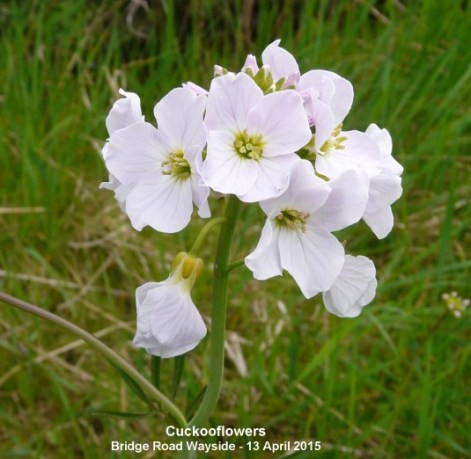
Millpond
News
The pen
Mute Swan was still sitting high on the reed
nest by the bridge on the town millpond when I passed
by at about 10am this morning. I could see the cob
patrolling the pond at the end of Nile Street as
usual.
Over on Slipper Millpond there was no sign of the
Great Black-backed Gulls. I am sure they have given up
on nesting here this year. I could see five Coot
chicks on the north raft, whereas previously I had
been told there were just four.
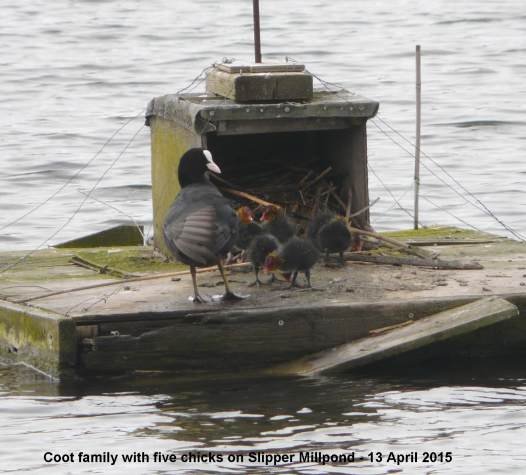
Cob
swan nest building
Having
recently lost its mate, this morning I found the cob
Mute Swan on the small island on Peter Pond. This is
where the swans have traditionally nested, though last
year the pair nested in the reedbeds on Slipper
Millpond. It was engaged in what I can only describe
as false nest building activity. I watched the bird
for about 15 minutes as it moved small pieces of grass
and reed towards a depression in ground where it was
sitting. Later it got up and moved more grass stems.
As far as I know the pen had done nothing towards nest
building before she went missing and, of course, there
were no eggs in the 'nest'.
I believe this type of
functionally inappropriate behaviour is referred to by
ethologists as displacement activity. Wikipedia
defines displacement activities as those which occur
when animals are prevented from performing a single
behaviour for which they are highly motivated. Typing
'loss of mate in male swan' into Google led me to a
rather sad case in Australia in which a cob Black Swan
refused to leave the nest after its mate was stoned to
death by a group of six teenagers. I gather this type
of determination to carry on regardless is not
uncommon in swans that have lost their mate.
Brook
Meadow
There was no
sign of the Treecreepers in the Crack Willows at the
south bridge where we thought they were nesting. They
have not been seen for a couple of weeks so it looks
as if they have moved on.
However, I was pleased to see the bright pink flowers
of Herb-Robert appearing as usual on the south side of
the bridge.
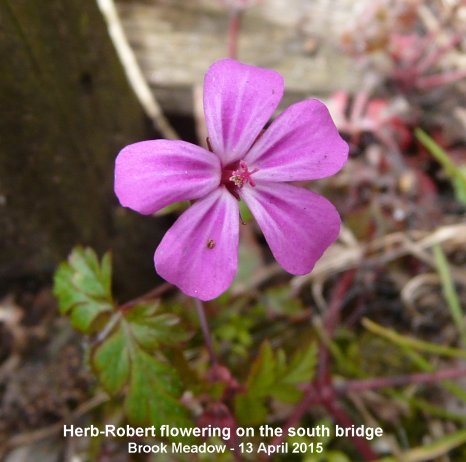
Pendulous Sedge
is now in flower alongside the path through Palmer's
Road Copse. It is not so abundant as in previous
years, having been severely cut back during the winter
by the conservation group, so you have to search
around to find the flowers.
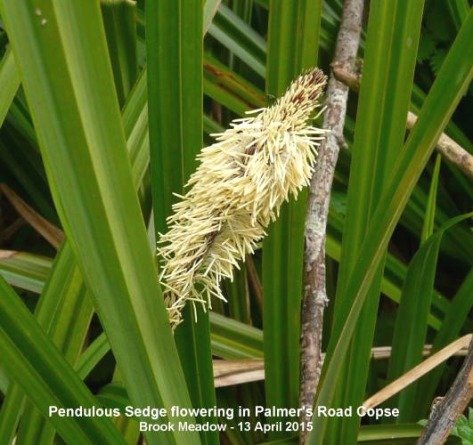
North
Thorney
I carried on
down to Thorney. There was no sign of an swans on the
Deckhouses Estate pond, though a Grey Heron was
standing sentinel-like on a small rock island in the
centre of the pond.
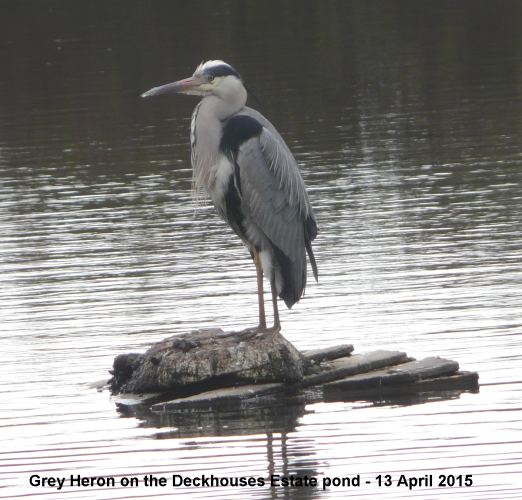
Walking along the old
ERA track I heard Cetti's Warbler, Chiffchaff and
Willow Warbler, but there was no sound of Sedge
Warbler or Whitethroat which I was hoping for.
However, I did hear my first Cuckoo of the year
calling faintly from the east side of Thorney. A
couple of Swallows were flying around near the
Marina Farm stables. I got a shot of one of them as it
perched on the overhead cables.
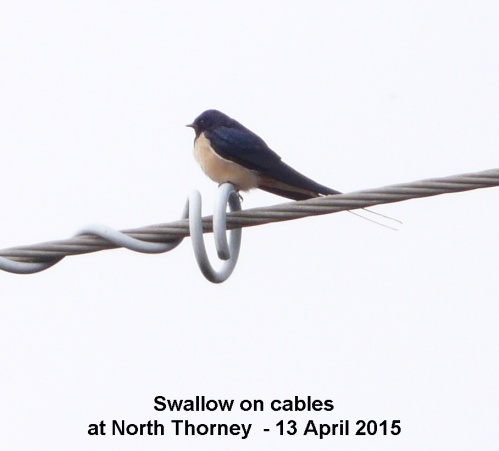
A very loud Song
Thrush was singing from the bushes while
Mediterranean Gulls flew overhead in a
never-ending stream continually calling. What noisy
birds they are. A Buzzard was soaring over the
reedbeds. I noticed some Field Wood-rush along
the edge of the track which I don't recall having seen
here before.
I walked very slowly
down the main track to the Little Deeps listening for
Sedge Warbler or Reed Warbler but I heard nothing to
indicate the presence of either of these two common
migrants. Maybe it is still a bit early for them.
The Little Deeps were very peaceful, but for the
whinnying calls of Little Grebes and the
splashes of ducks and Coot as they hurried across the
surface of the water. A pair of Canada Geese
flew off while I was there, honking loudly. I also
noted three pairs of Tufted Ducks. A Skylark
was singing from the large field to the south of
the Little Deeps.
Malcolm's
news
Malcolm
Phillips has been unwell and so has not been able to
get out in the usual way with his camera. We have
missed his regular contributions to the blog. However,
today he has been sitting up and got this butterfly
from his flat window. Nice one Malcolm, it is a
Speckled Wood - the first of the year for the
blog. Pity it was not on Brook Meadow. Malcolm says he
hopes to be out and about again soon.
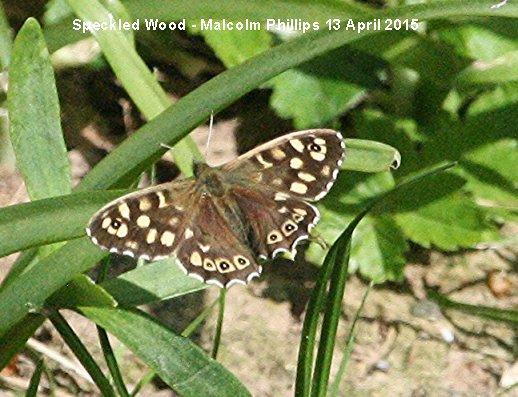
Langstone
Mill Pond
Peter
Milinets-Raby had a quick hour long look around
Langstone Mill Pond, walking in via Wade Lane (9:58am
to 11:13am - low tide).
Wade Lane: 1 Mistle Thrush, 1 Kestrel, 1 Buzzard
perched on its usual tree, 2 Chiffchaff singing, 4 Med
Gulls heading north, Blackcap singing, Swallow over
farm buildings. Peter got this unique photo of a
male Redstart with a Fox in the background on edge
of horse paddocks on the eastern edge of Wade Lane.
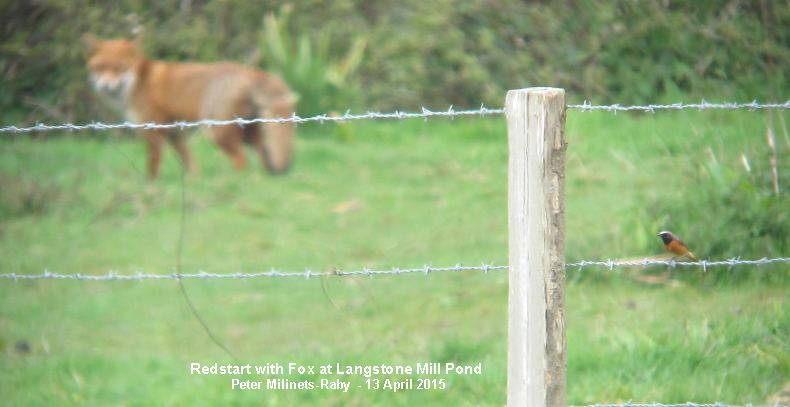
Flooded Paddock (now
dry): Another male Redstart being chased occasionally
by a Robin, Willow Warbler singing at the back, 7
Moorhen, Chiffchaff singing, Green Woodpecker, Med
Gull 2 north.
Langstone Mill Pond: Grey Heron colony: Top Holm Oak:-
still four juvs present. Lower Holm Oak:- Nothing,
gone. South Nest:- Two tiny young on view. Middle
Nest:- Adult sorting out at her legs as if there is
tiny young. Fifth & Sixth nests:- Adults
sitting.
Now the big surprise of the morning (apart from the 2
Redstarts) was a Grey Heron was standing next to a
substantial "construction" way to the south of the
main colony (adjacent and behind the island). Is this
a SEVENTH nest? I did not have the time to fully
check.
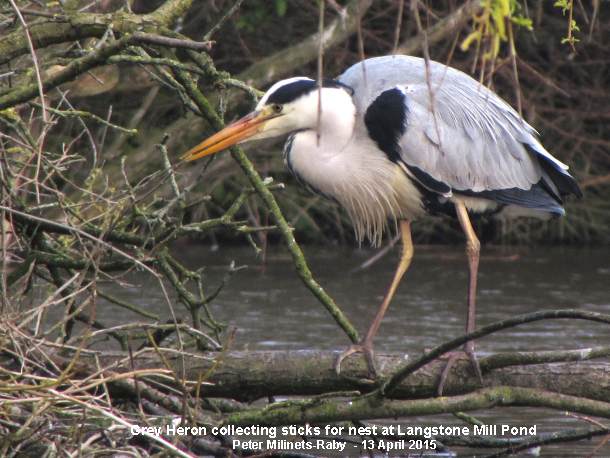
24 Little Egrets in
the trees, either sitting, displaying, stick fiddling
etc. So much activity, what fun!!
Reed Warbler heard singing in north reed bed,
Cetti's Warbler heard singing many times, A pair of
Tufted Duck, Mute Swan firmly on nest, 3 Willow
Warblers in the Sallow Trees in the north reed bed
with 2+ Chiffchaff and a male Blackcap. (An obvious
fall this morning).
Off Pook Lane: 1 Greenshank, 61 Black-tailed Godwit, 4
Bar-tailed Godwit, 1 Great Crested Grebe, 5 Shelduck.
SUNDAY
APRIL 12 - 2015
Brook
Meadow
Jean and I had
a stroll through Brook Meadow and down to Slipper
Millpond this morning. We met Pam Phillips who
confirmed that the Brook Meadow committee have agreed
to get a fisherman to catch the Pike in the
river. Let's hope he manages it soon as the Water
Voles will be getting into their breeding season.
The large Ash tree
on the railway embankment is now full of purple
flowers. I think they must be female flowers as the
tree has seeds, though the flowering of Ash trees is
mighty complex according to my book; ie "Some trees
change sex yearly, some carry branches of the wrong
sex, some are hermaphrodite and some produce dual sex
(perfect) flowers"
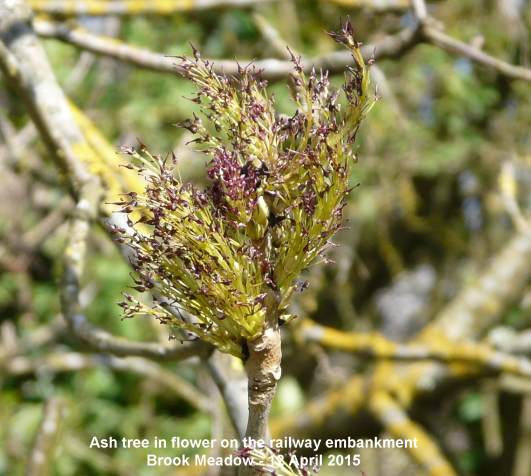
Cow Parsley is
now flowering on the north path, but little sign of it
elsewhere. Like most other flowers it is late this
year.
It was good to see the Rowans sprouting fresh
leaves in the Gwynne Johnson plantation on the east
side of the north meadow.
Walking round the
Lumley area we noted the emergence of brown flower
spikes of Greater Pond Sedge near the copse and
stream. However, this sedge appears to be spreading
onto the main grassland of the Lumley area which is of
some concern. There is still no sign of either Divided
Sedge or Distant Sedge which are also late coming
through.
Hermitage
Millponds
The lone
Mute Swan cob was on the east bank of Peter
Pond. Its mate the 'Polish' pen that it has nested
with for the past two years remains missing, presumed
dead. Over on Slipper Millpond we could just make out
3 and maybe 4 Coot chicks on the north raft; the nest
that was on the south raft has gone. There was no sign
of the Great Black-backed Gulls.
Mystery
moth - Angle Shades
I had several
replies to this query about the moth that Chris Oakley
found yesterday. The unanimous opinion was that it is
Angle Shades. Thanks to Mike Wells, Joyce Sawyer, Ros
Norton, John Walton and Ralph Hollins for providing
this information.
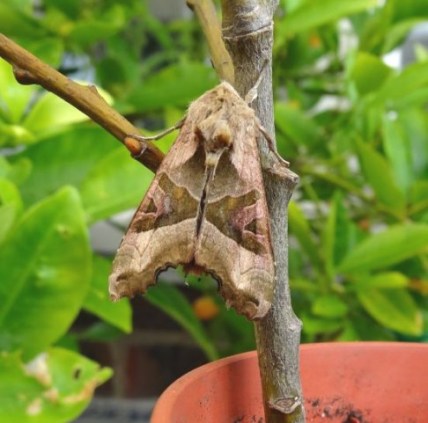
Ralph added the
following links which he thought would be useful . . .
http://en.wikipedia.org/wiki/Angle_shades
. . . http://www.sussexmothgroup.org.uk/speciesData.php?taxonNum=2306
"A resident species,
regularly reinforced by immigration. Often fairly
common to common and sometimes very common at my light
when migration takes place. Probably generally
distributed. Broods vary but range from two to three
per season, one of which is always partial. Adults
emerge from February to April, and sometimes from late
May to early July, but most numerously from mid-August
to early November. Larvae will eat "almost any green
herb". (Pratt, 2011)
Hedgehogs
fighting
Graham Petrie
sent the following links to Hedgehog videos in his
garden from last night. The first one also has a Fox
that looks like it was scared away by the commotion.
The second one shows a couple scrapping. Graham hopes
they did not harm each other. I assume this was two
males coming to blows over territory?
https://www.facebook.com/video.php?v=10206681946031609&l=3448559206757523036
https://www.facebook.com/video.php?v=10206681882590023&l=2148381122024686587
SATURDAY
APRIL 11 - 2015
Mystery
moth
Can anyone
identify this moth that Chris Oakley found in his
utility room? It's about one inch long, the wing
pattern and colouration are quite distinctive, but
Chris can't find it in any of his books. Nor can I. He
says the moth came from a pupae that was accidentally
dug up in the garden. He put it in a pot of compost
with a twig (to climb on) and it apparently hatched
out this morning and is now in a sheltered corner of
the garden.
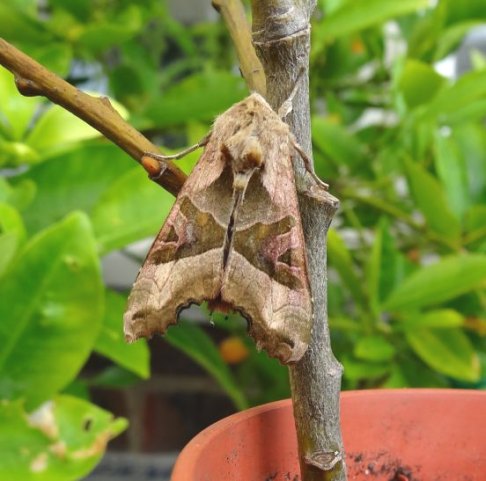
Holly
in an Oak tree
Following Jim
Berry's report in yesterday's blog of Daffodils
growing in a Magnolia tree in his garden in Rowlands
Castle, Chris Oakley sent me this photo of Holly
growing on an Oak tree in New Brighton Road on the
corner of Wickor Way. He says it has been there for
some years. Chris wonders what such plants feed on,
like the flowers that grow on buildings and roof tops,
presumably on nutrients brought in with the
rain.
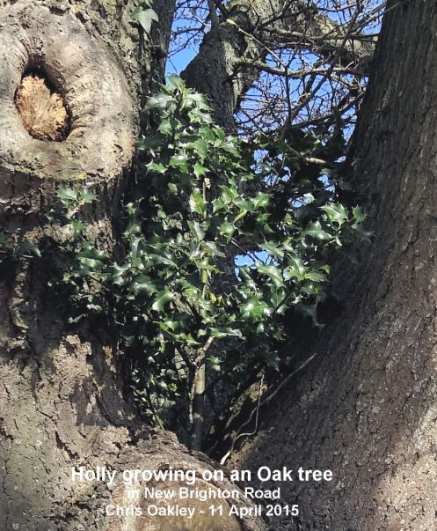
Warblington
shore
Despite the
grim weather Peter Milinets-Raby popped down to the
Warblington shore (6:46am to 8:38am - tide dropping).
The highlights before the rain set in were as
follows:
Ibis Field: 7 Little Egrets feeding, Chiffchaff
singing, Blackcap singing (first one here), 1 Moorhen,
Female Pheasant, 3 Song Thrush.
Conigar Point: Hedgerow behind point: 3 Willow
Warblers - none singing, just moving through, 2+
Chiffchaff - some singing, others moving through,
Blackcap male singing, 2 Swallows over, Cetti's
Warbler singing.
Brent Geese (two flocks moving east, 14 and 15 in
number), 2 Lesser Black-backed Gullls, 2 Great
Black-backed Gulls, A pair of Wigeon (very late), 10
Shelduck, 1 Greenshank G//R+BB//-), 2 Med Gulls
over.
Pook Lane: 1 Red Breasted Merganser, 16 Bar-tailed
Godwit, 98 Black-tailed Godwit (All in summer plumage
- Two with rings and according to my report I have not
seen them before. Are they Emsworth birds?
G//R+GY//- and G//R+OL//-.
4 Med Gulls over, 16 Brent Geese, 2 Greenshank
(RG///-+YY/-), 6 Knot, 2 Dunlin, 4 Shelduck.
Pook Lane track: 2 Long-tailed Tits, 3 Chiffchaff,
Pair of Blackcap, 2 Stock Dove, Recently ploughed
field along Pook Lane held 14 Med Gulls - 6 pairs and
two 1st summer birds, Male Pheasant.
Brian's note
regarding the colour-ringed Black-tailed
Godwits.
G+GY - was ringed at Farlington on 14-Sep-05 and has
been seen 14 times in Emsworth Harbour over the years.
Not a regular. My last sighting was on 26-Sep-13.
G+OL - I think this was also ringed in Sept 2005. I
have only seen this one in Emsworth Harbour twice over
the years, but have a number of sightings of it from
Langstone, Pagham, Farlington, etc. My last sighting
was on 16-Mar-11 at 'Texaco Bay' Hayling.
Reminder about Peter's
report summarising his bird sightings over the past
three years
Go to . . . http://www.peterspurplepages.webspace.virginmedia.com/
Click on the Birds of Warblington & Emsworth - A
personal Report to get a pdf download.
Thornham
Lane
Heather Mills
reports on this morning's walk along Thornham Lane to
Prinsted by the Havant Wildlife Group. Their sightings
included four Spoonbills flying in from the harbour to
Thorney Island. These will be the four juveniles that
have been in and around Chichester Harbour for a while
- see SOS Sightings. For the full report go to . . .
Havant
Wildlife Group
- 2015 reports.
FRIDAY
APRIL 10 - 2015
Hollybank
Woods
On this fine
spring morning I cycled up to Hollybank Woods for a
short walk around this beautiful local woodland.
Having my bike with me, I stuck to the main paths and
did not go onto Longcopse Hill. Walking was quite easy
as the paths were remarkably dry and even the
notoriously muddy bits were not too bad today.
Walking up the main track to the woods I noticed that
the Cherry Laurel blossom was just starting to
emerge, a bit later than normal like most flowers this
spring. The large housing development at the top of
the drive should be near completion. There is a large
fence separating the estate from the track with no
obvious access.
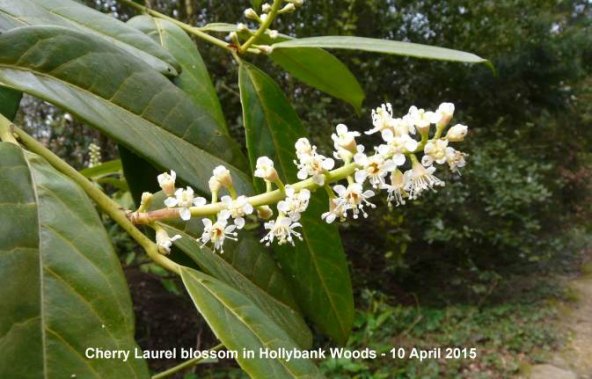
The notice board at
the entrance to the woods indicates that the Spring
Walk this year is being done by John Goodspeed on
April 25th. This is the walk that I have done for the
past 10 years or so. I was not actually asked this
year though I don't mind not doing it as my health is
not all that good. I am sure John will do a good job.
Other walks include Trees by Andrew Street on May 17th
and Butterflies by Jane Brook on July 19th.
I was interested to
see the good progress made by the conservation group
in coppicing the Sweet Chestnut woodland on the
east side of the main path, having completed their
work on the western side.
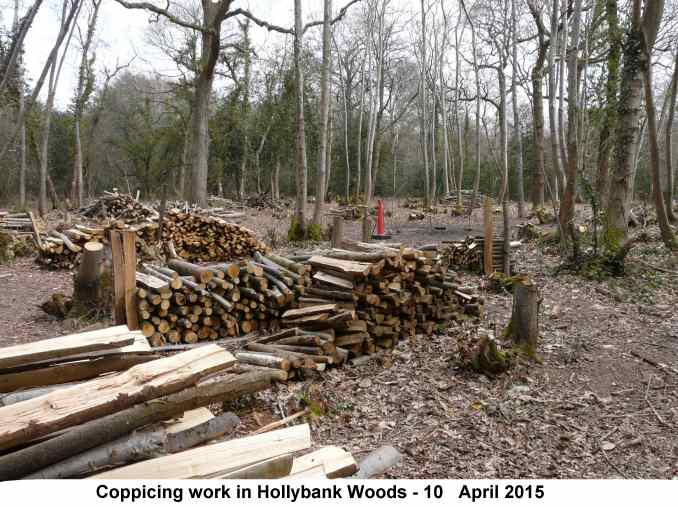
I had a quick look at
the old Holly Lodge clearing where I found the usual
crop of Primroses and Cowslips.
Field Wood-rush is just starting to come up in
the usual spot in the southern section of the
clearing. This plant is much shorter than the Hairy
Wood-rush that I found outside Bowhill House yesterday
with a more compact and less spread inflorescence. The
hairs identify the plant as a Wood-rush.
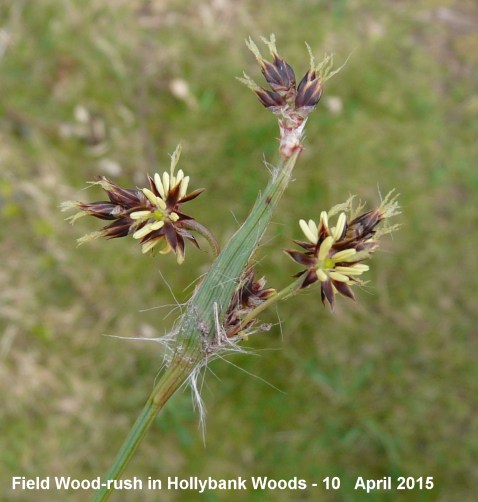
I had a look at the
Bluebell area in the south eastern section of
the woods; there were plenty of leaves, but no sign of
any flowers as yet. The Hollybank Bluebells are always
later than those at Ashling Wood. Just a few Wood
Anemones were out in the Bluebell area. The large
Wild Cherry tree was full of buds with blossom
about to burst. This tree is always a fine sight.
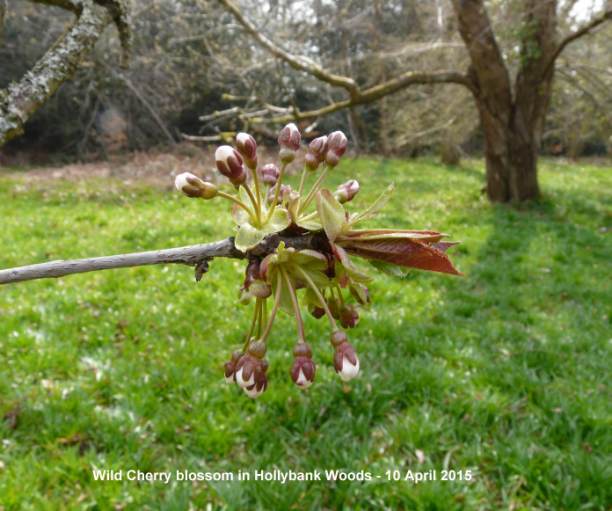
The woods were full of
bird song as usual with most of the residents in good
voice including Nuthatch, Jay, Robin, Blackbird,
Chaffinch, Wren, Great Tit, Song Thrush and
Woodpigeon. The regular summer migrants Chiffchaff and
Blackcap were also singing well. This confirms the
arrival of Blackcaps in force. I also heard one burst
of song from a Willow Warbler just north of the
southern Bluebell area. Willow Warbler is not such a
regular or abundant migrant in the woods, though I
usually hear it in the Birch scrub on Longcopse
Hill.
Francis Kinsella had quick walk in Hollybank Woods
this evening and saw 4 Jays together in a small
area, including this handsome fellow, which was
rummaging through the undergrowth.
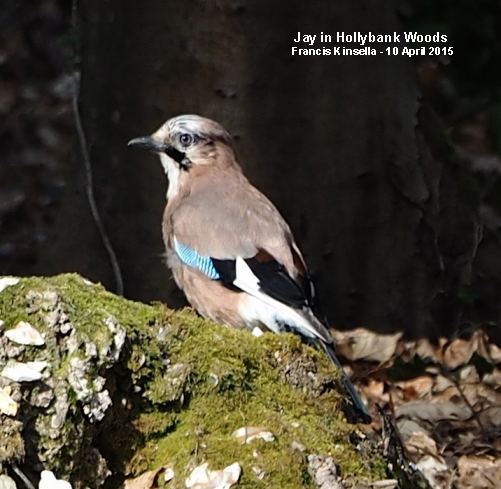
Speedwell
query
Ralph Hollins
queried the plant that I called Thyme-leaved Speedwell
from the Westbourne Open Space on Apr 7. Ralph thinks
the photo I took does not look like that species and
he is right. I had my doubts about it at the time due
mainly to the hairiness of the leaves, but could not
think what else it could be.
Ralph sent me a photo of Thyme-leaved Speedwell that
he found on his lawn to show what the plant really
looks like. He says it forms a dense mat of the
ground, sending up vertical flowering spikes from
which the flowers do not stand out on long stems as in
my photo. They also have leaves of a dull greyish
green colour and not the bright green of my photo.
Here are the two photos for comparison with mine on
the left and Ralph's Thyme-leaved Speedwell on the
right. Clearly, they are not the same species. I am
not sure what my plant is, but my best guess is
Ivy-leaved or Common Field Speedwell.
Millpond
News
Jackie-Michelle
Daines spent a couple of hours at the town millpond
this afternoon with her friend Rose. The nesting pair
of swans were both next to the nest and she was able
to count 8 eggs when the pen moved off the nest for a
drink in the stream. That means she must have laid an
extra egg after the 7th on Mar 31. In view of this I
shall need to adjust my hatching date to May 10th.
Daffodils
in a tree!
Jim Berry has
something very unusual in his Rowlands Castle garden -
namely, Daffodils growing in a tree. Jim says he has
never before seen Daffodils or any similar flowers
growing in such a position some 12-14 feet above
ground level. The tree is a Foxglove tree (Paulownia
tormentosa) and the Daffodils look similar to some of
the smaller variety growing in our and neighbouring
gardens. Presumably seed or a bulb has been carried up
there by a bird or a squirrel. Ralph Hollins is also
puzzled, but notes that Daffodils can be grown from
seed but they take at least 5 years to come up.
Personally, I would go along with Jim that they were
put there by a Grey Squirrel, but forgotten. Has
anyone else had Daffodils growing in their trees?
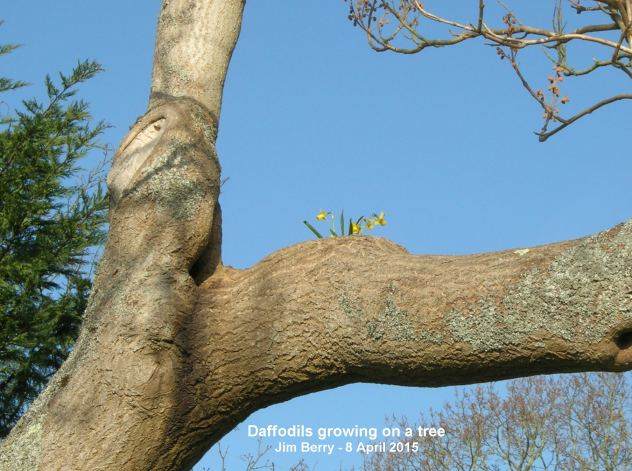
Baffins
Pond
Eric Eddles
photographed this odd-looking Canada Goose on Baffins
Pond two days ago and decided to check it out with
expert Dave Appleton who identified the Embden-Canada
hybrid for him (see blog entry for Feb 15th). Dave
said the Baffins goose is a Canada-Barnacle hybrid.
One can see the Barnacle influence in the extra area
of dark on the chest.
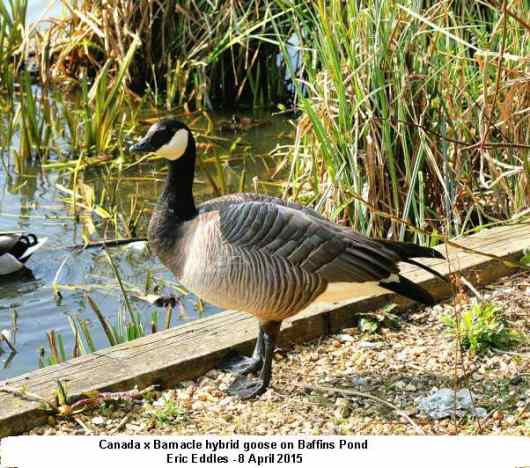
Warblington
shore
Peter
Milinets-Raby was out this morning to visit the
Warblington shore (6:44am to 9am - very low tide). The
highlights were as follows:
Ibis Field: 2 Moorhen, Green Woodpecker,
Pheasant heard, 2 Chiffchaff singing, 12 Med Gulls
over heading inland, Cetti's Warbler singing from
stream vegetation.
Conigar Point: Cetti's Warbler singing from
rear of small reed bed (a second singing territory -
obviously there has been an influx of this species to
suitable habitats this spring!), Greenshank
G//R+BB//-, 8 Brent Geese, 9 Shelduck, 4 Mute Swan,
Male Wheatear on sea wall.
Pook Lane: 16 Med gulls feeding on field, 10
Shelduck, 21 Bar-tailed Godwit (all in winter
plumage), 12 Black-tailed Godwits (all in summer
plumage), 2 Grey Plover, 6 Teal, 23 Brent Geese, 7 Red
Breasted Merganser, Yellow Wagtail over calling, 2
Meadow Pipits over north, Linnet east, Sand Martin low
over mud then north.
Flooded Horse paddock - now dry enough to play
cricket, 9 Moorhen, 2 singing Chiffchaff, Green
Woodpecker heard.
Langstone Mill Pond:
Grey Heron Colony: Top Holm nest- five
youngsters. Lower Holm nest - nothing, probably
fledged. South nest: - two tiny young being fed.
Middle nest - Adult sitting. Fifth nest - adult
sitting. Sixth nest - very big construction with adult
sitting.
Little Egrets:- (returned on 5th April) 3
'sitting' in Holm Oak, 2 stick arranging in Grey Heron
middle nest tree, 1 actively displaying with lots of
guttural noises. Pond island - 5 birds on three nests
on tiny tree that has small leaves - lots of display
and stick collecting.
1 Swallow over (My first seen over Beacon Square on
5th April), Great Spotted Woodpecker, Cetti's Warbler
singing from area behind mill (third spring bird in
this area!!!), A pair of Reed Buntings chasing each
other after lots of singing and response calls from
female, Mute Swan on nest - male chasing everything!
Reed Warbler singing occasionally from reeds, Kestrel,
Sparrowhawk, Stock Dove, Chiffchaff singing.
Peter's
Bird Report
Peter
Milinets-Raby has just finished writing up the results
of his bird surveys that he has been carrying out over
the past three years in the Langstone, Warblington and
Emsworth areas of the coastline. Peter has contributed
regularly to this blog over this time providing
detailed counts of birds that he has seen in these
areas and now we have a neat summary in proper Bird
Report format dealing with each species in turn. This
is a remarkable achievement. Peter's report for the
years 2013 and 2014 can be seen on his web site at . .
. http://www.peterspurplepages.webspace.virginmedia.com/
Click on the Birds of Warblington & Emsworth - A
personal Report to get a pdf download. The 2015
results will be added later. Peter says he would
appreciate any comments and or additions.
THURSDAY
APRIL 9 - 2015
Willow
Warbler in garden
I had a lovely
surprise when I went into the garden first thing this
morning - I heard the sweet descending song of a
Willow Warbler coming from the Large Silver
Birch tree in our neighbour's garden. I had a look in
the tree and could clearly see two small warblers, so
maybe there were two Willow Warblers! These will
certainly be birds moving through the area on their to
their breeding grounds further north. My only other
garden sighting of a Willow Warbler was also in this
Silver Birch tree in April 2010 - and it was also
singing. The tree overhangs our garden, so I usually
include the birds I see in my garden list.
More
Bee Flies at Stansted
It seems to be a good year for Bee Flies. We have had
sightings on Brook Meadow and today I saw two feeding
on Grape Hyacinth flowers in the Stansted garden with
their long probosces. See blog for April 7th for more
information about their breeding behaviour.
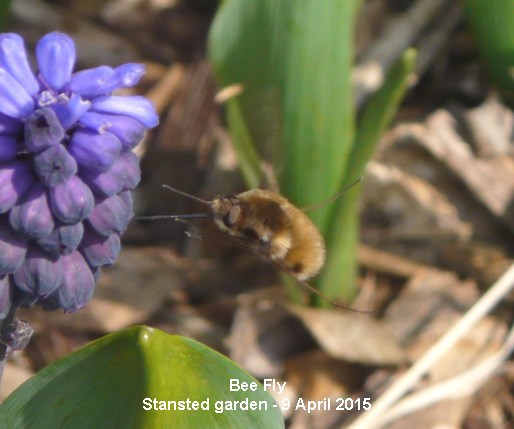
Weeping
Ash
After having
coffee in the pavilion cafe Jean and I had a stroll
around the arboretum. We were very interested to find
a specimen of Weeping Ash - Fraxinus excelsior
'Pendula' which we had never noticed before, despite
having walked round the arboretum hundreds of times!
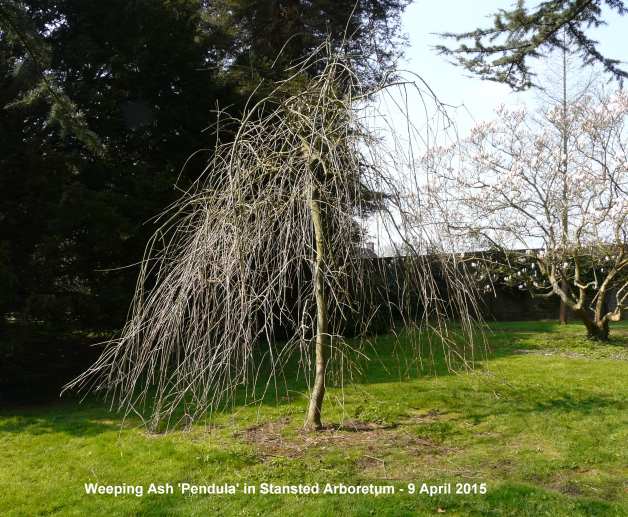
I was alert to it
since I had seen an example of this tree only two days
ago (April 7) on the roadside verge at the junction of
Redlands Lane and Nursery Close in North Emsworth. As
shown in the photo below the Emsworth tree is a larger
more mature tree than that in the arboretum, but both
have the distinctive black buds of an Ash and long
thin branches spreading to form an umbrella like head.
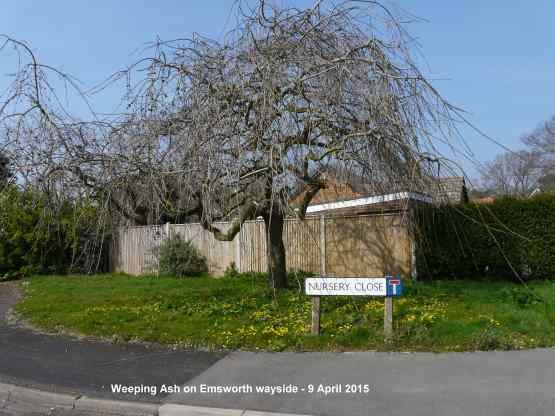
Spring flowers of
interest in the arboretum were my first
Marsh-marigolds in the pond and my first
Ground-ivy.
Birds heard singing included Chiffchaff, Blackcap and
Willow Warbler. We also heard the distinctive croak of
a Raven as it flew overhead. They are probably
nesting on the estate again.
Ashling
Wood
After a break
for lunch at the Fox and Hounds at Funtington, we made
our way over to East Ashling to see how the
Bluebells were getting on in Ashling Wood. I
find that this is the best place to come to see the
first Bluebells and it also has a magnificent display
when they are fully out. Turning left off the main
road from Funtington just before East Ashling village,
park on the roadside just before the junction leading
to West Stoke. The Bluebell wood is on your left
through the (new) kissing gate.
Bluebells seem to depend very much on the spring
temperature; with a warm spring like last year they
are early. They were fully out on March 23rd when I
visited. However, today, there were very few flower
spikes open, but lots more to come. I would give them
a couple of weeks for a really good showing. Wood
Anemones and Dog's Mercury were looking very good.
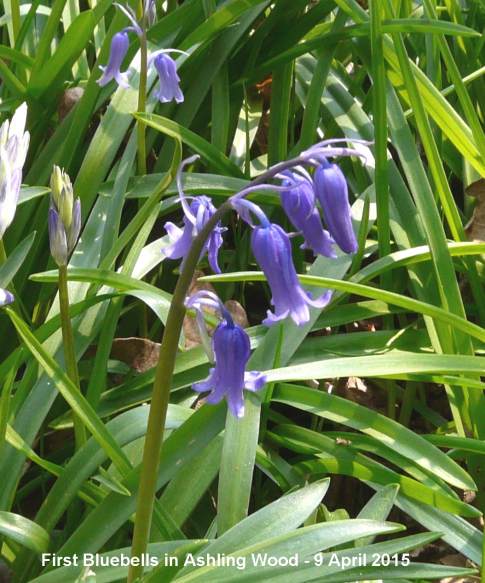
You can't miss the
noisy Rookery at the entrance to Ashling Wood.
I counted 25 active nests today, which is about the
same as in 2013, but well down on the high of 42 nests
in 2009.
Hairy
Wood-rush
Taking the
single track road towards Funtington I stopped near
the entrance to Bowhill House to check the Hairy
Wood-rush (Luzula pilosa) which grows well on
the grass embankment east of the drive to the house.
Heath Wood-rush is taller than the more common Field
Wood-rush and has more open inflorescences with stalks
radiating in all directions and with single flowers at
the end of each stalk. A possible alternative would be
Southern Wood-rush, but that has slender curved
branches slightly dropping to one side. However, it
would not surprise me if this is what it was!
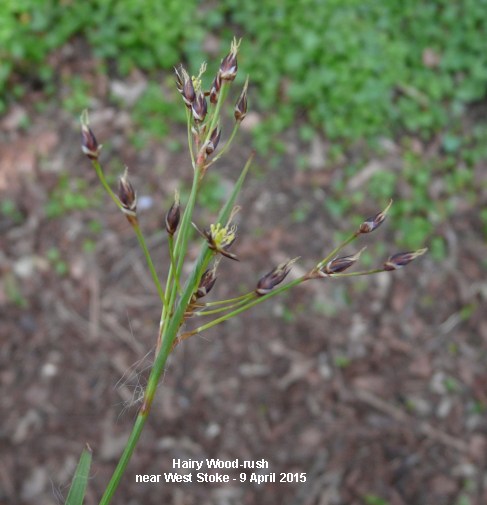
I checked with the
Sussex Flora and was reassured to find Luzula
pilosa was listed as being present in tetrad
SU80E. Also, on the embankment is a good crop of
Common Dog-violets.
Brook
Meadow
Malcolm
Phillips got his first photo of a male Orange Tip on
Brook Meadow today. What the heck has been eating that
leaf?
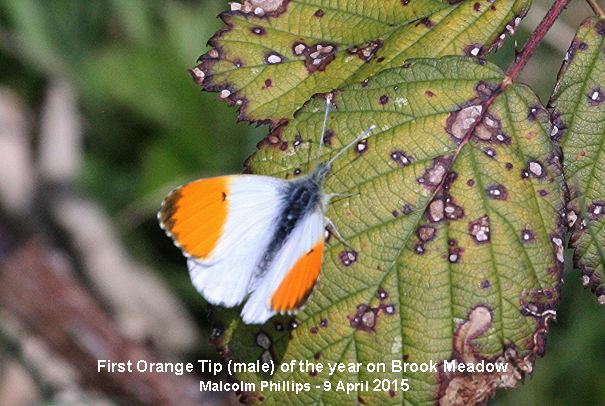
He also saw a small
blue butterfly fly past, but could not get a photo.
This was almost certainly a Holly Blue which
would be expected at this time of the year. The other
possibility is Common Blue though this appears
later.
But the photo I liked best was this great shot of a
Bumblebee with its face covered in yellow
pollen feeding on a Dandelion flower. The combination
of red tail and all back body would suggest it was a
Bombus lapidarius.
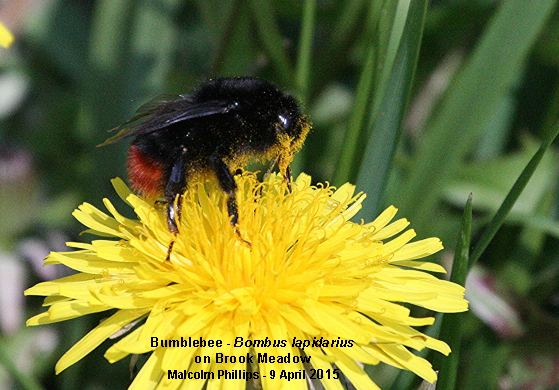
While standing at the
observation fence Malcolm also saw a smaller
Pike, only about half the size of the large one.
So we have at least two to get rid of for the sake of
the Water Voles.
Mike's
Robin
Having been
'trained' by the Robin to hold his meal worms, Mike
Wells has now learnt about its digestive system. Mike
has learned that meal worms go in at one end and a
faecal sac is passed to the parent from the other end.
Alimentary, as Mr Holmes would say!
WEDNESDAY
APRIL 8 - 2015
to
Thorney Island
It was a fine
spring morning with no wind, ideal for a cycle ride
down to Thorney Island.
On the way I passed a rather lonely cob Mute
Swan on the east bank of Slipper Millpond. Its
mate (the 'Polish' pen with pink legs and feet) of
several years has gone missing, presumed dead, but the
cob still waits in hope. Let's hope it teams up with
another pen swan for next year's nesting.
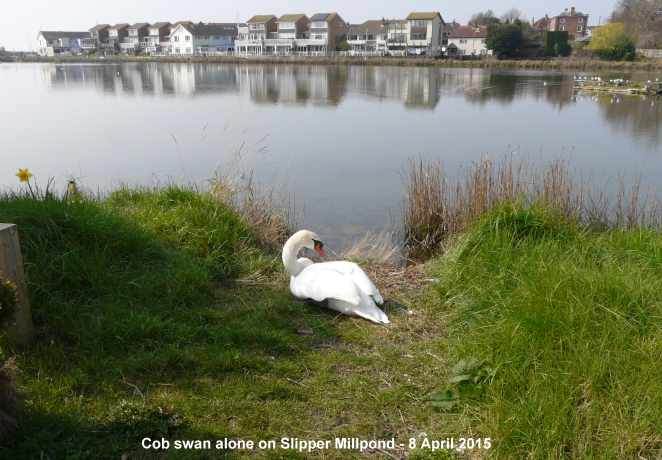
Before going down to
Thorney I had a walk along the marina seawall which is
an excellent point to observe the eastern harbour in
winter. But today there was little in the harbour
except for gulls. Everywhere I went I was regaled by
the yelping calls of Mediterranean Gulls flying
overhead. Out in the harbour I could see a good
collection of them on a seaweed island. I can see at
least 14 in this photo.
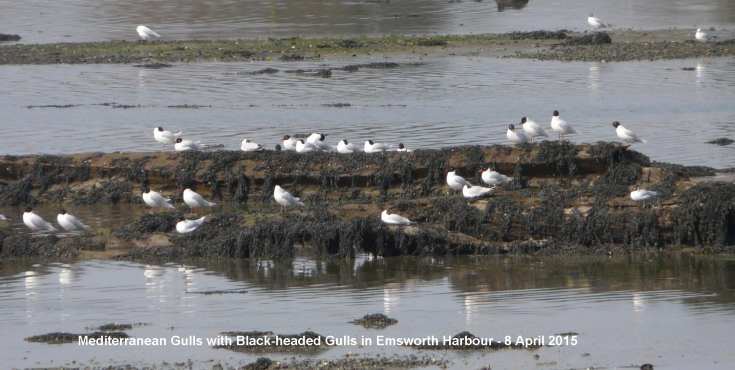
There was little of
botanical interest on the seawall itself, though the
Hemlock leaves were looking very fresh. This
interesting plant grows very well at this site.
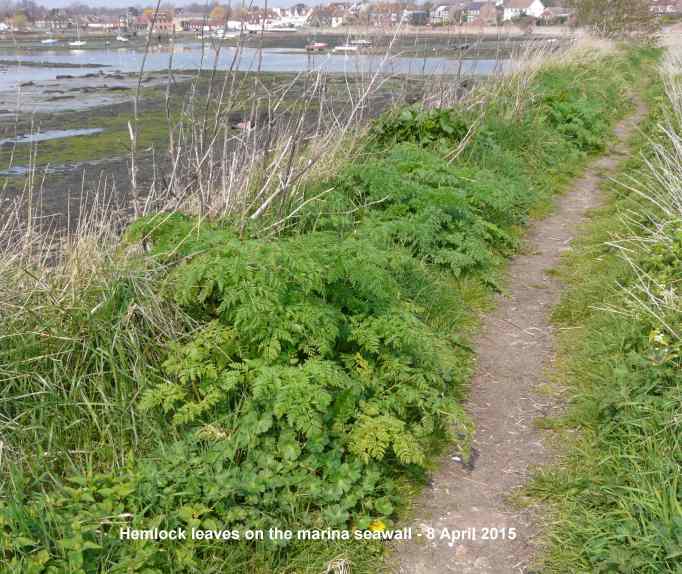
I saw several
butterflies on the seawall including this Small
Tortoiseshell which perched for a photo showing me
its mottled underwings for a change.
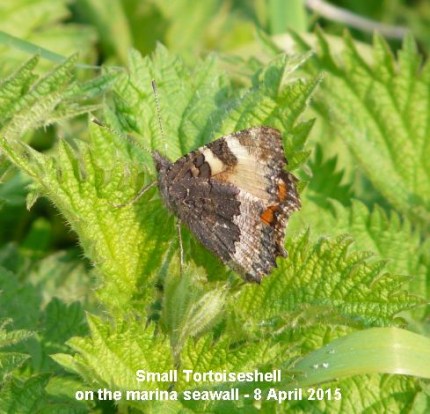
Also on the seawall I
spotted my first 'Nursery-web spider'
(Pisaura mirabilis) of the year basking in
the sunshine on a dock leaf. This is a hunting spider
which typically sunbathes with its front two legs of
each side extending forward. The female will carry its
egg cocoon in its fangs. The spider gets its popular
name from its habit of spinning a silken tent over the
eggs before they hatch.
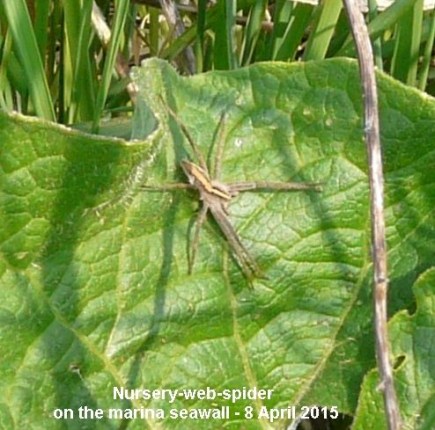
Coming down from the
main seawall look out for the mass of tiny white
flowers of Common Whitlowgrass which carpet the
ground at the bottom of the slope.
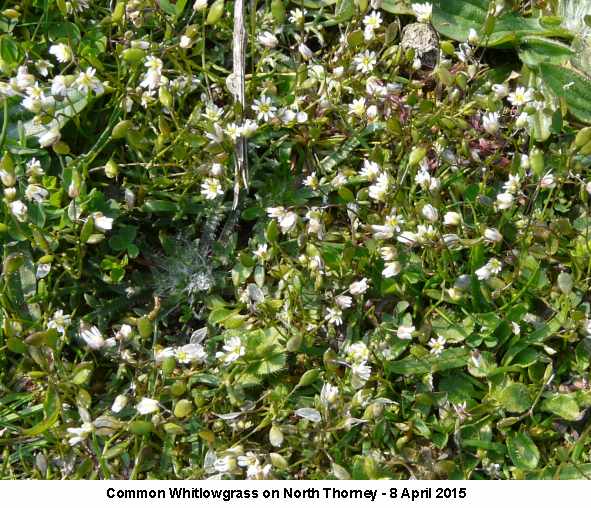
I locked my bike to
the metal gate before walking along the old NRA
track towards Thorney Road. Note NRA stands for
National River Authority which used to own this track
in the old days. I think it is now owned by the
Environment Agency, but public access is allowed along
it.
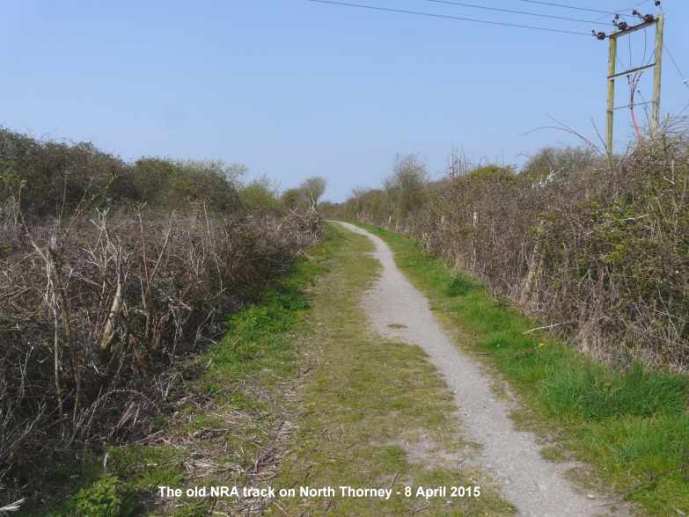
I love this track at
this time of the year where Cetti's Warblers shout out
their songs - it's almost like being in Mallorca. The
track is of special interest for early arriving
migrants. Today I heard the first three common
arrivals, Chiffchaff, Blackcap and Willow Warbler
singing their varied songs. But no sight or sound
of anything else, no Swallows over the old Marina
Farm, no Sedge Warbler in the bushes and no Cuckoo on
the overhead cables. Hopefully, they will be here in a
week or so. The gentle but long carrying purring song
of the Turtle Dove which used to be so common here is
sadly no more.
Note: Tony Wootton did see Swallows over this track
this morning, so they are here - see his report below.
I made my way down to
Little Deeps where I found the usual crop of
Coltsfoot on the side of the track in front of
the deeps. I was surprised to find a Mallard family
with 3 ducklings. This must be the biggest one I
have seen in years. I pity that poor mum trying to
feed and protect such a large brood.
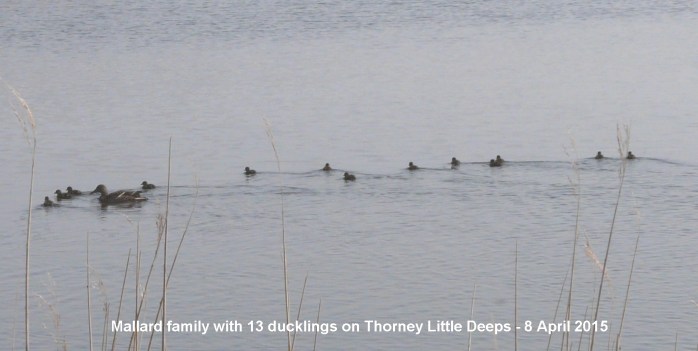
I expected to find the
regular Mute Swan pair nesting, but there was
no sign of them on the deeps. However, I did find them
a little way south of the deeps in the small canal
that runs parallel with the track. I was very
surprised to see that the pen had the pink legs and
feet of a 'Polish' swan. This could not be the missing
Slipper Millpond pen as swans mate for life and don't
swap around half way into a breeding season. No, this
must be a second Polish swan, probably from the brood
on Peter Pond several years ago which included two
pure white cygnets - ie Polish swans.
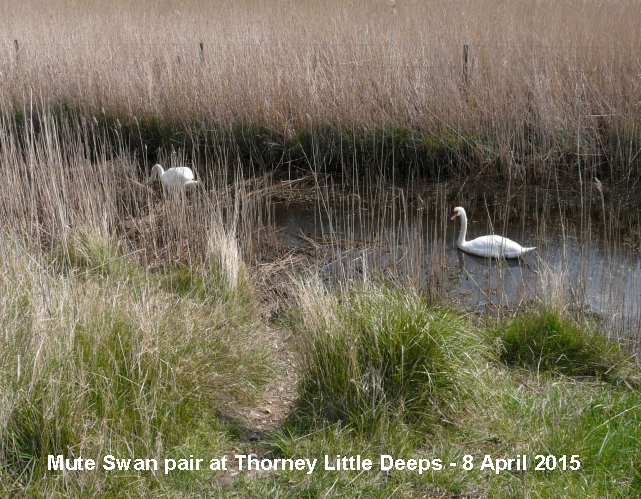
While studying the
swans I spotted a Grey Heron struggling to
swallow a large fish. I watched it for several minutes
as it gradually got it down its gullet only for the
fish to emerge again. Finally, the Heron flew off with
the fish still in its beak.
Tony's
news
Tony Wootton
went for a mooch along the old NRA track this morning.
Apart from bumping into Barry Collins who was looking
for Sedge Warblers, he managed to photo a Cetti's
Warbler, one of four that were around. He also saw
his first Swallows of the year, 5 or 6 flew
over. One seemed to be having a good look around the
the horse stables.
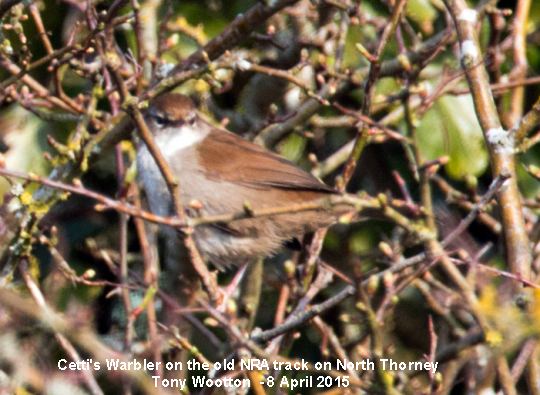
Brook
Meadow
Malcolm
Phillips went around the meadow as usual today. He got
an excellent photo of a Bee Fly which seem to
be fairly common at the moment. Note its extra long
proboscis.
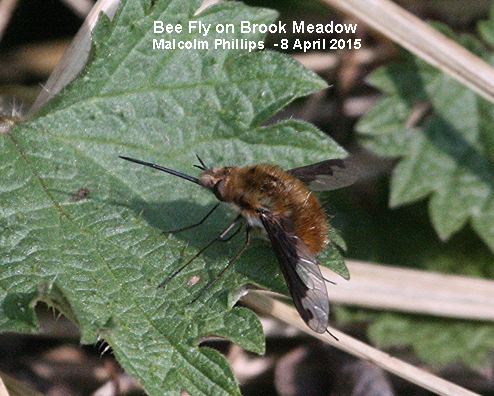
Malcolm also noted the
first leaves sprouting on one of the Horse
Chestnut trees.
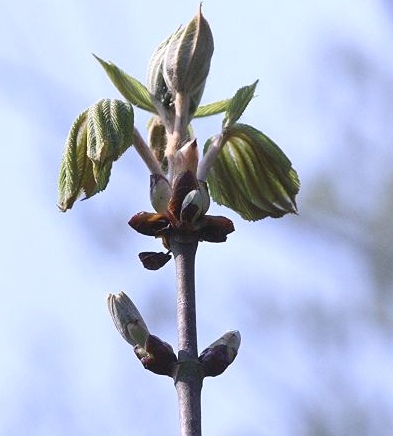
Eyed
Hawkmoth
Chris Oakley
found this Eyed Hawkmoth in his utility room this
morning. It was covered in cobwebs, so Chris cleaned
it up as best he could but it was in a very poorly
condition. He put it outside on a plant with a small
drop of honey beside it but sadly it didn't last.
Chris thought it was a very early hatch probably
brought on by the warm weather.
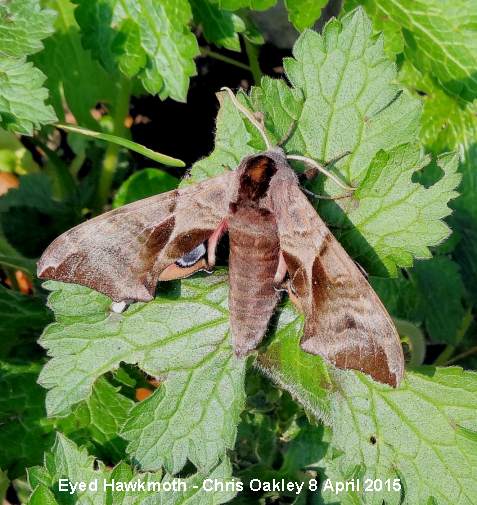
TUESDAY
APRIL 7 - 2015
Brook
Meadow
I had a stroll
around the meadow and was pleased to hear my first
Blackcap song of the year in Palmer's Road Copse
near the south bridge. In this habitat, I assume this
would be the first of the migrants rather than a
wintering bird. It is a little later than usual.
I met Malcolm Phillips and we walked round the meadow
together admiring the butterflies on the way. Peacocks
were particularly abundant - I counted at least 6. We
also saw one Orange Tip flying over the railway
embankment, but it did not stop for a photo. Malcolm
also had one Orange Tip yesterday which did not stop.
Here is one of the Peacocks taken by young
Thomas Irons.
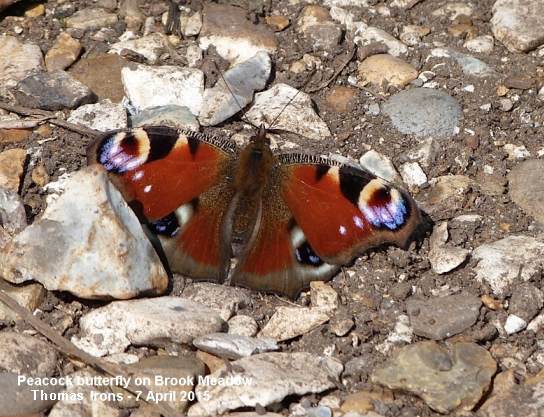
Malcolm showed me the
spot on the north meadow where he had the 7-spot
Ladybirds yesterday and they were even more
numerous today; I estimated at least 50 and all the
same species. They were in the northern section of the
north meadow near the brambles.
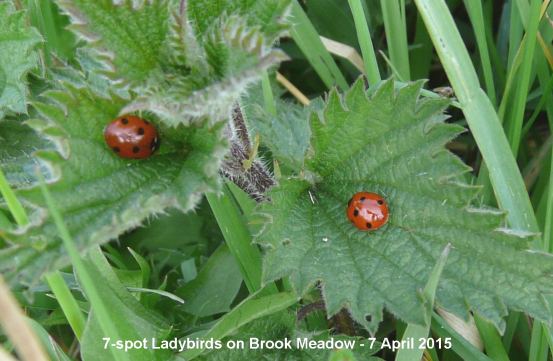
Waysides
News
This afternoon
I got the bike out to have a cycle around some of the
local waysides. Starting in Bridge Road car park, I
found the first open Cuckooflower of the year.
This is late in comparison with previous years; on
this day last year we had 466 in flower, though that
was exceptionally early.
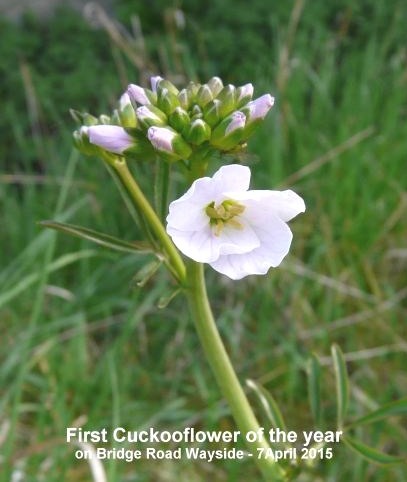
I then went to the
Christopher Way wayside where I could see the leaves
of Wild Clary coming up on the grass verge
immediately west of the official wayside. This is
where they were growing last year with very few on the
main wayside.
Moving on to the Westbourne Open Space, I could only
see a few Meadow Foxtail spikes. They must be later
coming up this year. One new flower for me this year
was Thyme-leaved Speedwell on the edge of the
cycleway.
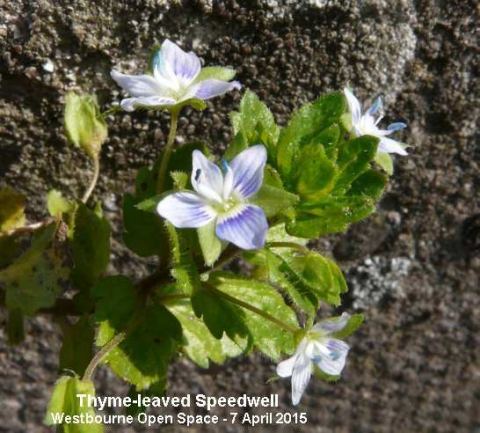
Then, I went over to
Redlands Lane to have a look at the Nursery Close
wayside. It was there I met Chris Oakley who was
mowing a grass verge outside his house - not the
wayside I might add! The wayside has a very good
display of Common Dog-violets with pointed
sepals and notched spurs. There are also some white
Sweet Violets. I am finding this white variety in
several locations. I puzzled over the speedwells as I
always do at this time of the year, but I think they
were Common Field Speedwell and Ivy-leaved Speedwell.
We also had Hairy Bittercress with 4 stamens.
The grass verge on the north side of the junction also
has lots of wild flowers and some not so wild. It has
a very unusual tree in the centre of the verge - I
think it is a Weeping Ash 'Pendula' with long
thin branches spreading to form an umbrella like head.
I did not take a photo but there are plenty on
Google.
It was on this verge that I had my first Lords and
Ladies of the year with an open spathe revealing
the brown spadix.
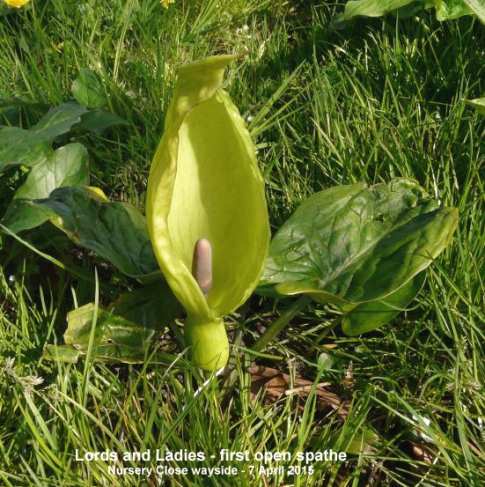
Hampshire
Farm
Crossing
Redlands Lane I decided to have a quick look at the
Hampshire Farm open space. I found what I think is the
resident Pied Wagtail perched on the fence
around the pond.
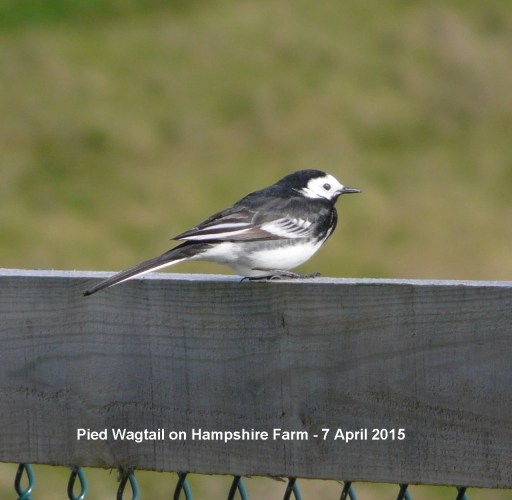
There was nothing on
the pond itself but for a Black-headed Gull. I was
pleased to see my first Swallow skimming down
to the water on the pond and later hunting for insects
over the main grassland. Excellent sighting.
Meanwhile, a Skylark was singing from the
plantation area.
Cetti's
Warbler on Baffins Pond
On his morning
walk round Baffins Pond Eric Eddles heard the
explosive song of a Cetti's Warbler and managed to get
a sighting and a photo of this cracking bird. Nice,
one Eric. That must be a first for the pond?
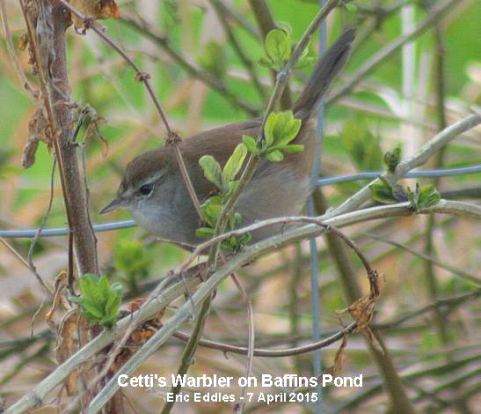
Bee
Flies and footballers
Ralph Hollins
pointed out the similarity between Bee Flies and
footballers with the following link which describes
how the female Bee Fly lays her egg on the ground
close to the tunnel which leads to the nest of a
mining bee, then 'flicks' the egg (Beckham-like) down
the tunnel where it will become a parasite of the bee
larva. See . . . http://www.nhm.ac.uk/nature-online/species-of-the-day/biodiversity/loss-of-habitat/bombylius-major/biology/index.html
Great
Black-backed Gulls
On Sunday
Ralph saw the pair of Great Black-backed Gulls on the
Slipper Pond (on the water, not the raft) so it seems
they may not have given up the idea of nesting
there.
Brimstone
Francis
Kinsella enjoyed the butterflies that the Bank Holiday
sunshine brought out. He saw Peacock, Comma, Small
Tortoiseshell and this cracking Brimstone in Hollybank
Woods. What is it feeding on?
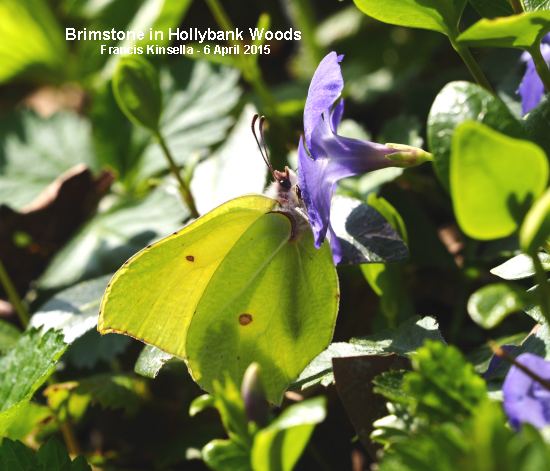
Clever
Robin
Mike Wells
sent a couple of photos of one of the Robins nesting
in his back garden. Mike says it took a week for this
Robin to train him to do this!
MONDAY
APRIL 6 - 2015
Brook
Meadow
Malcolm
Phillips spent most of the day on the meadow where he
saw lots of butterflies, including Peacock, Small
Tortoiseshell, Small White, Brimstone, Comma and the
first Orange Tip of the year. Here are two
Peacock butterflies that he captured in mating.
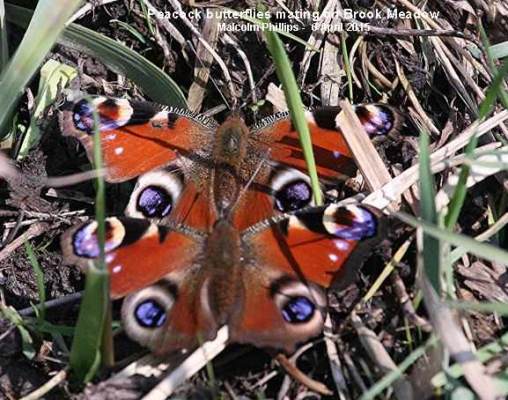
He also got the first
7-spot Ladybird of the year on the meadow.
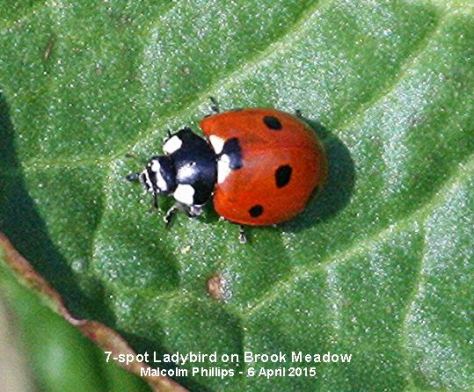
These are two of the
species that BBC Springwatch are asking for records of
- Orange Tip and 7-spot Ladybird.
Finally, Malcolm got some shots of a pair of birds
that were clearly nesting. He was puzzled as to their
identity, but they look like Dunnocks to me.
The photo on the left shows a chick and the one on the
right an adult. That is a good breeding record.
Charlie Annalls was
also on Brook Meadow today and met up with Malcolm who
pointed out the best places to see interesting birds.
She failed to see the Treecreepers, but was pleased to
spot a tiny Wren flitting along a fallen tree
next to the stream. She says, "Wrens normally
disappear very quickly but this one seemed to be
playing hide and seek with me".
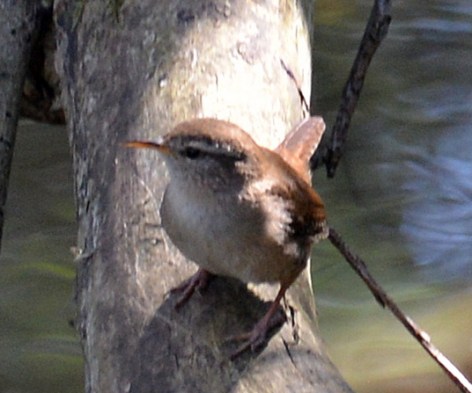
More interesting was
the Chiffchaff she found at the north end of
the meadow near the railway. "It was persistent in one
particular tall tree and stayed for quite a few
minutes for me. When I downloaded the photos I could
see why - there were hundreds of tiny little flies.
The Chiffchaff must have had a proper feast up there.
It seems very yellow - is this normal? " Yes.
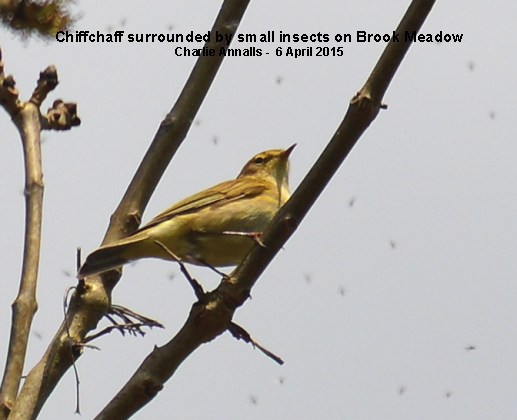
Tony Wootton was also
on Brook Meadow today and photographed this Bee Fly
(Bombylius major) this afternoon. One can
just see its long proboscis in the photo.
Interestingly, this is the first Bee Fly I have
recorded for Brook Meadow, though Bryan Pinchen did
find it during his Insect Survey on the meadow in May
2010.

Millpond
News
I walked round
the town millpond at about 9,30 this morning before
the family invasion! Lovely spring day with a slight
chill in the air. The resident pen swan was high on
her reed nest near the bridge and looking very secure
brooding her seven eggs. Her mate the cob was
patrolling the northern section of the pond.
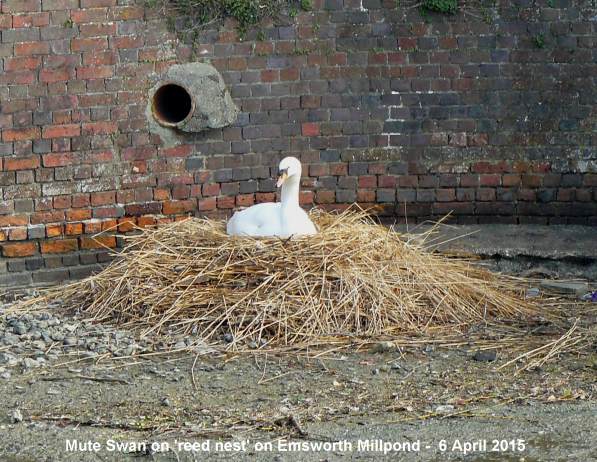
The other pair of
swans were displaying in the southern section of the
millpond, but sadly they have nowhere to nest.
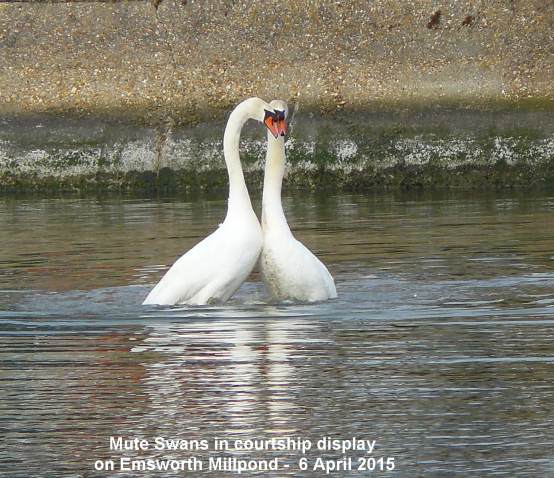
During her visit to
Emsworth Charlie Annalls had the pleasure of seeing
the first Coot chicks on the north raft on
Slipper Millpond. I think I can see four chicks in the
photo.
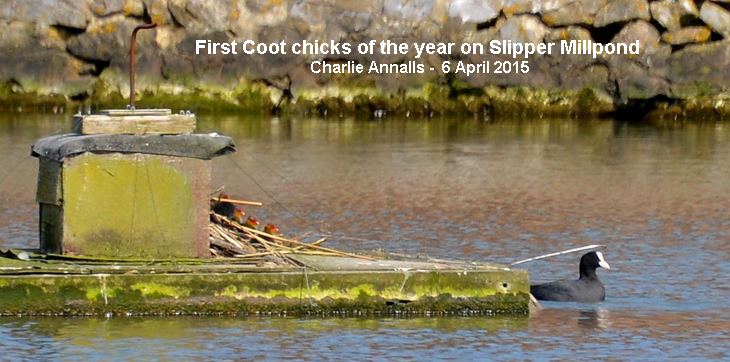
Garden
Blackcap
Tony Wootton
had a female Blackcap in garden this morning and
wonders how much longer will she stay. Not much longer
I would guess. He has not seen the male for 4 days
now.
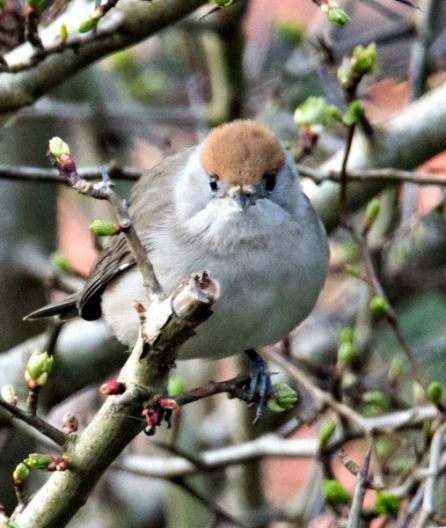
Baffins
Pond
Last week Eric
Eddles met Mike Wells at Baffins Pond looking for the
Gadwall but it was nowhere to be seen. Since then it
has returned and to-day Eric had an opportunity to see
it out of the water. Eric also reports that the Swans
on Baffins Pond have so far produced three eggs.
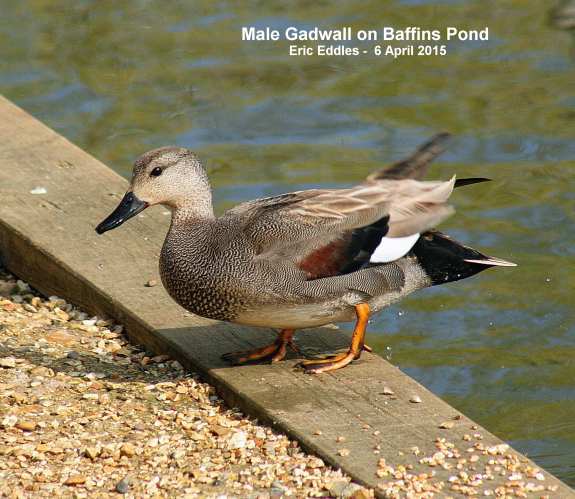
Horsetails
correction
Martin
Rand helpfully corrects my rather casual comment about
the nature of Horsetails in my fortnightly wildlife
summary (see below). I said that Horsetails are
unusual in having two stages of growth; in spring they
have brown stems with cones, then in summer they
produce green stems with vertical ridges without
cones. However, as Martin indicates this is not
strictly correct.
He says, "There are only two species in Britain that
do what you say, producing brown spore-bearing stems
early and completely separate green sterile stems
later. These are the Field Horsetail (Equisetum
arvense) that you mention, and the Great Horsetail
(Equisetum telmateia), which is also quite
widespread in Hampshire and which you have a bit of in
the Emsworth / Warblingron area. A couple of others
sometimes produce their spore-bearing cones on paler,
initially not very branched stems but these then grow
on to resemble the sterile ones. They are the Wood
Horsetail (Equisetum sylvaticum), our prettiest
Horsetail but not found in your corner of the county;
and the Shady Horsetail (Equisetum pratense)
which in Britain is only found in the north. All the
rest bear their cones on green shoots."
Field
Horsetail with spore-bearing cone on Brook Meadow (4
April 2015)
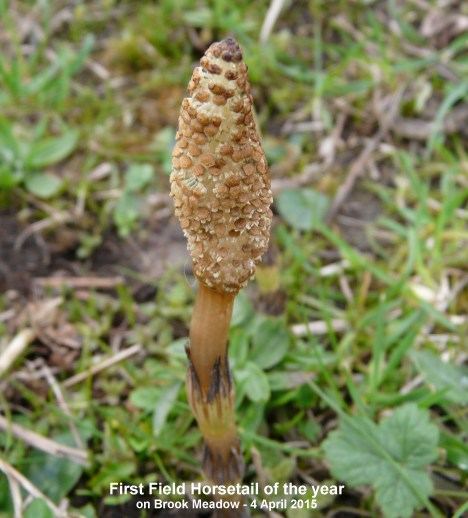
For
contrast here are
Great Horsetail with brown stems taken on the Selangor
Avenue path - on left
and Marsh Horsetail with green stems taken on
Fishbourne Meadows - on right
WILDLIFE
NEWS SUMMARY FOR WEEKS 13-14
Brook
Meadow news
Treecreepers
are nesting behind the bark of one of the old Crack
Willow trees in Palmer's Road Copse; they are easily
seen from the south bridge. Malcolm Phillips has been
studying them closely and his photos are on the
Emsworth blog. This is a great chance to see this
elusive little bird really well.
Chiffchaffs are always the first of the summer
migrants, announcing their arrival with their cheery
'chiff-chaff' song. Malcolm got photos of one with
reddish legs suggesting a Willow Warbler. However,
these birds are tricky to distinguish until you hear
them sing. So, please sing to us!
We have had just one sighting of a Water Vole over the
past two weeks which is not a good sign. They should
becoming active at this time of the year. The
conservation group are still pursuing the Environment
Agency to get rid of the huge Pike that we have in the
river. Pike of this size can be a serious predator of
young voles in particular. Malcolm has got several
photos of the beast and thinks there could be more
than one!
Malcolm has also seen and got photos of the first
Common Lizards of the year, usually basking in the
warm sunshine on top of the black felt mats. These
mats are used for a survey of reptiles.
Butterbur
count
I did the
annual count of Butterbur flower spikes on Brook
Meadow on Mar 30. I counted a total of 792 spikes
which slightly down on last year's count of 824, but
still very high in comparison with the years before
2011. Most of the flowers are now in the area below
the main seat where they are increasing year by year.
Full details of the counts can be seen on the web site
at . . . http://www.brook-meadow.hampshire.org.uk/bm-plant-counts.html
Grasses,
sedges and horsetails
I always look
forward to the first signs of less conspicuous plants
on Brook Meadow. Meadow Foxtail is the earliest of the
spring grasses to show; this week I found the first of
its cylindrical spikelets out on the north meadow.
Soon they will be everywhere. Also dotted around the
north meadow are the fertile cone-bearing stems of
Field Horsetail. Horsetails are unusual in having two
stages of growth; in spring they have brown stems with
cones, then in summer they produce green stems with
vertical ridges without cones. Down by the Lumley
Stream the first dark brown flower spikes of Greater
Pond Sedge are now showing through the reeds. There is
no sign of Divided Sedge or Distant Sedge on the
Lumley area at the moment, but they should be out any
time. See
comment on Horsetails from Martin Rand in blog for
Monday 6 April
Waysides
News
My best
wayside find of the spring was a crop of flowering
Coltsfoot on the waste ground to the north of Emsworth
Railway Station. They can easily be seen from the new
access ramp. They are mostly yellow flowers, but some
have an orange hue. This is the only local site for
Coltsfoot that I know of in Emsworth; the nearest
being on the west side of Thorney Little Deeps.
There is the usual fine display of Blackthorn blossom
on the path behind Lillywhite's Garage. Blackthorn
blossom opens later than Cherry Plum with which it is
often confused. Blackthorn flowers are smaller than
Cherry Plum and come out before the leaves.
It has been a good spring for Sweet Violets. They are
still showing well on the grass verge of Warblington
Road, just before the junction with Valetta Park and
on several other verges. Chris Oakley also reports
seeing them on the Redlands Lane wayside, including
white ones.
It has also been a good year for Lesser Celandines,
particularly good near the southern entrance to Bridge
Road car park as well as in many other places around
the town.
But what has happened to the Cuckooflowers? On this
day last year I counted 450 in flower on the wayside
in Bridge Road car park, but this year there are
hardly any showing at all.
Millpond
News
This year,
thanks to the efforts of Jackie-Michelle Daines, the
pair of Mute Swans on the town millpond have had a
supply of fresh reeds to construct their nest. This is
a big improvement on the situation over the last two
years when they had to make do with a nest made up of
bits and pieces of debris and litter. Egg laying is
now complete and the pen swan is snug on the nest
brooding 7 eggs. She will be brooding for 36 days from
the laying of the last egg, except for brief periods
off the nest for feeding when the cob takes over. My
predicted date for hatching is May 8th. As always, the
nest attracts a constant audience of locals and
passers-by on the bridge.
I think this may be the only swan's nest in Emsworth
this year as the pen of the Slipper Millpond pair (the
one with pink legs and feet) has gone missing. The cob
stayed around for a while, but has now given up and
left the pond. My guess is that the missing pen was
the bird that the RSPCA had to put down following the
attack on the town millpond on Mar 21.
There is no sign of any nesting activity by the Great
Black-backed Gulls on the centre raft on Slipper
Millpond this year. So it looks as if they have gone
elsewhere after three fairly successful years - much
to the relief of the local residents I would guess.
Harbour
news
As you must
have noticed, the harbour has fallen eerily silent
with only the calls of Oystercatchers and
Mediterranean Gulls echoing across the mudflats. Brent
Geese, Wigeon, Teal and waders have all gone, heading
north towards their breeding grounds on their
incredible journeys. They include our very own Spotted
Redshank which has been at Nore Barn for the 11th
winter running. Our last sighting was Mar 20, which is
much in line with previous years. Will it return again
next autumn for its 12th winter with us? Who knows?
Let's hope so, for this tiny bird has now become an
integral part of the local scene. Nore Barn just would
not be the same without it.
Other
news
Malcolm
Phillips has seen and photographed a Cetti's Warbler
from the small footbridge at the north of Peter Pond.
Remarkably good views are possible if you are patient!
Chris Berners-Price recently heard (but did not see) a
Cetti's Warbler singing from the reedbeds to the north
of Nore Barn. A first?
The Coots nesting on the raft on the Sadler's Walk
pond have produced a brood of four chicks.
Peter Milinets-Raby has been monitoring the Grey Heron
colony in the trees behind Langstone Mill Pond. He
says there are six nests with birds sitting on some
and youngsters in others.
Swallows have been seen in many locations along the
south coast and should soon be with us in Emsworth.
The rest of the summer visitors should not be far
behind.
SUNDAY
APRIL 5 - 2015
Peter
Pond
Malcolm
Phillips says the top of Peter Pond is where most
things happen right now. For over half an hour,
standing on the small footbridge to the north of the
pond, he watched two Brown Rats eating what
looked like a dead Pigeon on the edge of the water.
The one at the front of the photo looks quite pale
compared with the one at the back. Maybe a youngster?
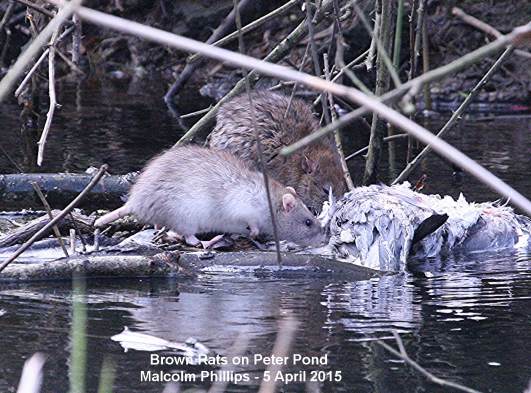
While watching the
rats, Malcolm also spotted and photographed what
appears to be a resident Cetti's Warbler. We
have had a couple of recent hearings and sightings of
this bird. The Peter Pond path is clearly a good spot
to see this very elusive bird, that most people only
hear and never see. It sings its name
'chetti-chetti-chetti' very loudly. Let's hope there
are two birds and they decide to nest here. That would
be a first.

Waysides
News
Chris Oakley
is pleased to report that the Sweet Violets are
at last flowering on the Redlands Lane wayside. He
says "they are a lot later this year but there is a
lovely selection of shades from the very pale through
to the darkest purple. Best of all there is a
beautiful clump of white Sweet Violets, perhaps fifty
or more. It's not unusual to see the odd one, but to
find such a large clump is very heartening. The Lesser
Celandines are coming to an end but It would seem that
there is a good selection of other plants now pushing
through so it may prove an interesting
year."
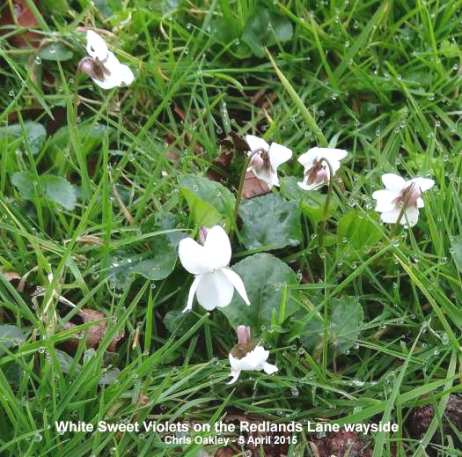
SATURDAY
APRIL 4 - 2015
Brook
Meadow
I had a stroll
through the meadow this afternoon where I found some
early signs of spring flowering.
A few flower spikes of Meadow Foxtail were out
on the north meadow. Very soon the whole area will be
adorned with these attractive grass spikes. Meadow
Foxtail is the earliest of the spring grasses to come
up. Another good place to see this grass is on the
Westbourne Open Space wayside at the top of Westbourne
Avenue near to Westbourne.
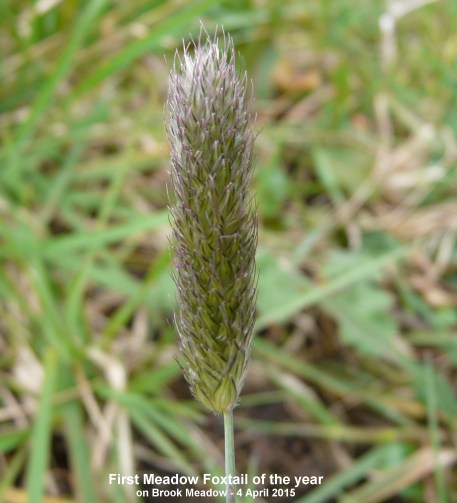
Another common spring
plant on Brook Meadow in the spring is Field
Horsetail. I could see numerous stems on the cut
grassland of the north meadow with cones from which
spores are released. Field Horsetail is the most
common horsetail on Brook Meadow, whereas Marsh
Horsetail is quite rare and hard to find. Horsetails
are distinctive in producing non-green unbranched
fertile cone-bearing stems in spring; in summer they
produce green, usually branched, sterile stems without
cones, but with vertical ridges.

Down by the Lumley
Stream on the Lumley area were the first dark brown
flower spikes of Greater Pond Sedge. The very
similar Lesser Pond Sedge tends to grow on the river
bank on the west side of the meadow, but I could not
find any today. I was expecting to see some early
signs of Divided Sedge and Distant Sedge on the Lumley
area, but I could not see any. I will look again in
the week.
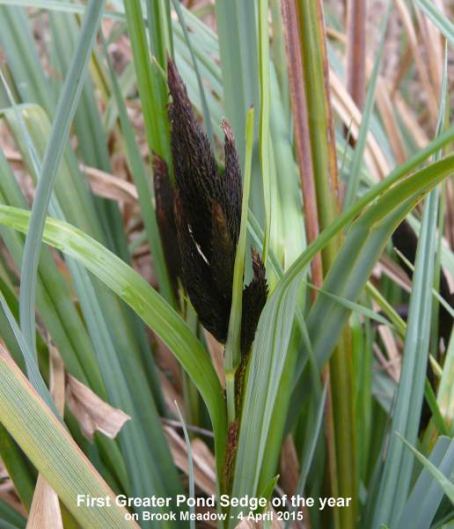
Malcolm Phillips was
on the meadow briefly, but enough time to catch one of
the nesting Treecreepers in the Crack Willows
near the south bridge.
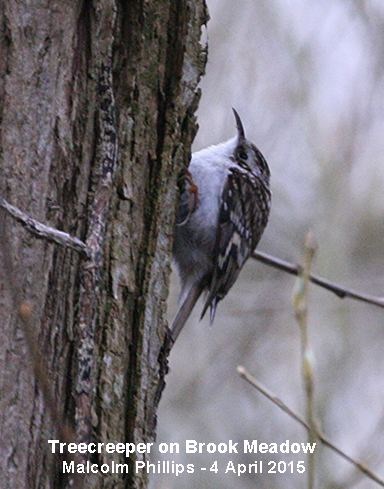
Waysides
News
There is the
usual excellent display of Blackthorn blossom
on the path behind Lillywhite's Garage. Blackthorn
flowers open later than those of Cherry Plum with
which they are often confused. The Blackthorn flowers
are smaller than Cherry Plum and come out before the
leaves.
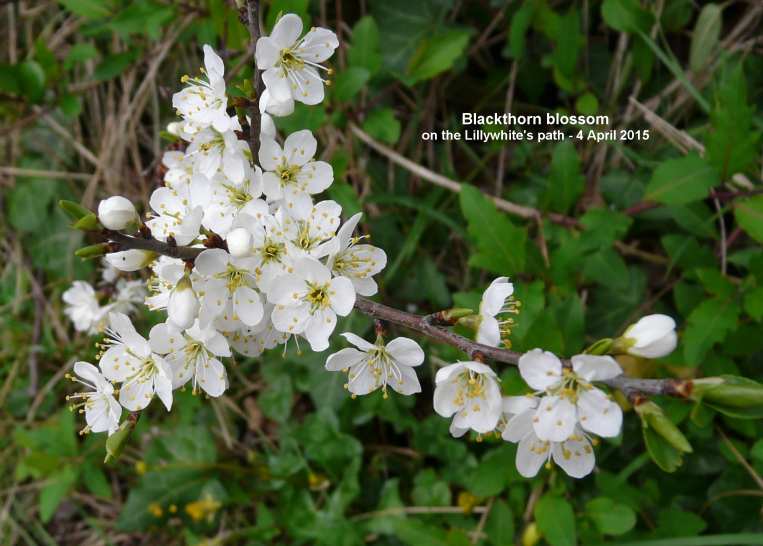
The Sweet Violets and
Primroses are still in flower on this wayside. I also
found a single flowering plant of what I think is
Early Dog-violet (aka Wood Dog Violet) with a straight
dark violet spur (not notched like Common Dog-violet).
Grape Hyacinth is flowering on this path and Summer
Snowflake, which is a first for this wayside.
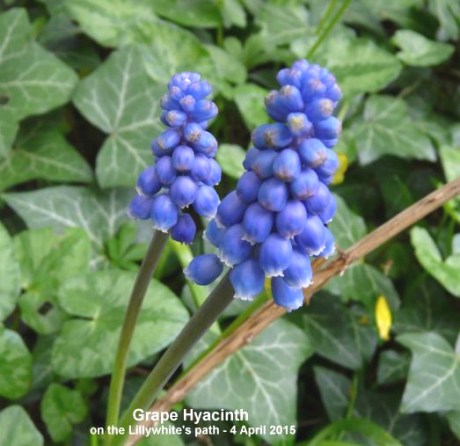
Bullfinch
in garden
Over the last
month Patrick Murphy has had a couple of fleeting
visits from a male Bullfinch, but this morning it
stayed for a while longer enabling Patrick to get a
quick shot of this lovely bird. Bullfinch is a fairly
uncommon bird to have in the garden. It is ranked 25th
in the BTO Garden BirdWatch rankings for this area
with 12% of particiants reporting it.
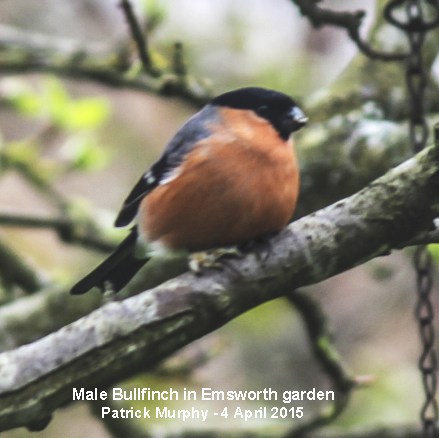
FRIDAY
APRIL 3 - 2015
Millpond
News
When I passed
by the town millpond at 10am the pen swan was snug on
the nest near the bridge brooding her 7 eggs.
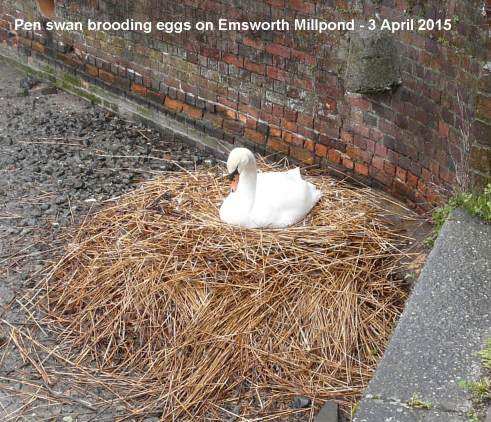
The cob was further
down the pond busking with what I assume was the
second pair of swans that have been competing with the
residents for territory.
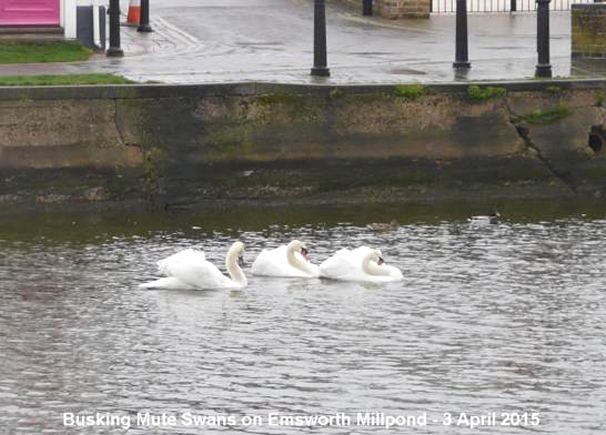
If this was the second
pair then, clearly, we must look elsewhere for the
victim of the nest attack on Saturday 21 March. I
still think the swan that the RSPCA had to put down
after the attack could have been the pen from the
Peter Pond/Slipper Millpond pair since the attack
coincided with her disappearance. Her mate, the cob,
has been alone on the Hermitage Millponds ever since.
Unfortunately, the RSPCA did not provide information
about the colour of the legs and feet of the injured
swan; if they had been pink this would have confirmed
the bird as the pen from Peter Pond.
Walk
to Nore Barn
Jean and I had
a walk to Nore Barn this afternoon. On the way along
Warblington Road we admired the fine display of
Sweet Violets on the grass verge near the
junction with Valetta Park which have been showing
well for several weeks. We also noted the white
bell-shaped flowers of Three-cornered Garlic
growing beside the hedge of house number 59
Warblington Road. The flowers of this plant have a
green line down the petals; the similar flowers of
Summer Snowflake have a green spot at the tip of its
petals.
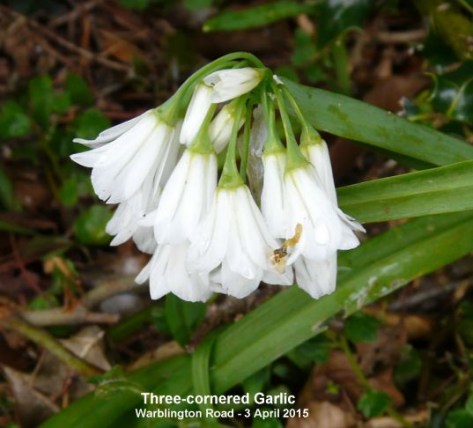
The tide was
completely out at Nore Barn and the harbour looked
totally empty, all we could hear were the calls of
Oystercatchers over the mudflats. However, of more
interest, we met Chris Berners-Price who told me he
had recently heard a Cetti's Warbler singing
from the reedbeds to the north of Nore Barn. That is
probably a first for that site?
On the way back along Western Parade we noted that the
Hoary Cress was in bud, but not quite showing its
white petals. But Honesty was flowering for the
first time.
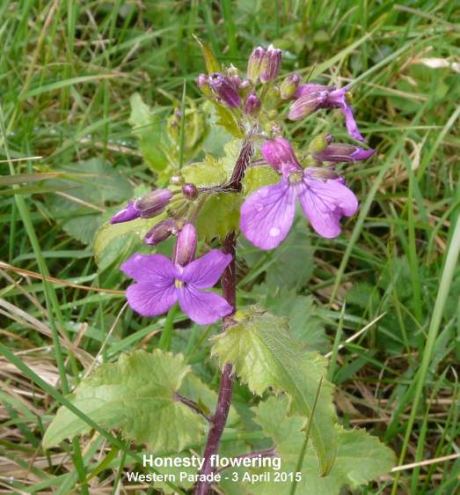
Brook
Meadow
Malcolm
Phillips spent some time on the meadow today. The
first thing he saw was a Kingfisher at the
north bank then the large Pike just up from the
north bridge. This is the chap that we are hoping the
Environment Agency will trap and remove from the river
to protect young Water Voles on which it predates.
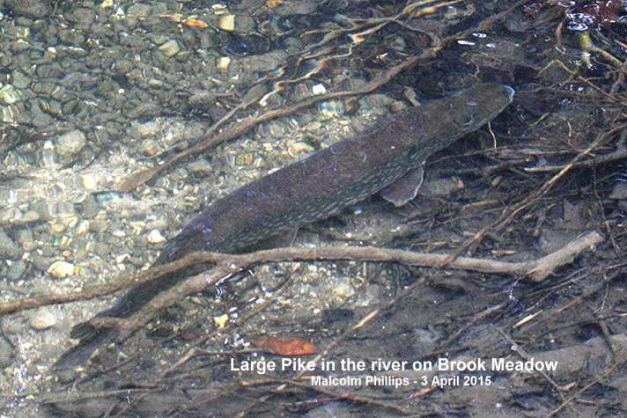
Further south a Grey
Heron was in the open space by the S-bend plus an
obliging Song Thrush.
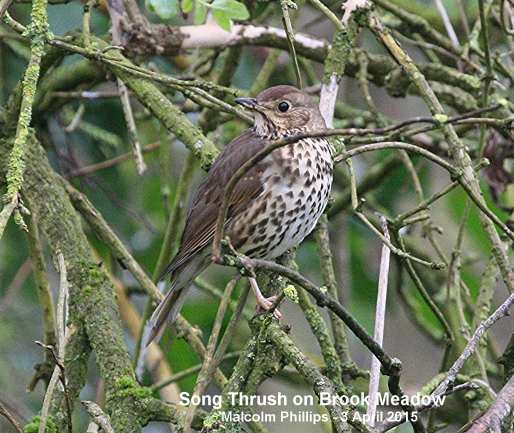
Malcolm also got this
excellent photo of two male Blackbirds
together, quite an unusual sight, I would think,
at this time of the year when territorial disputes are
at their height?
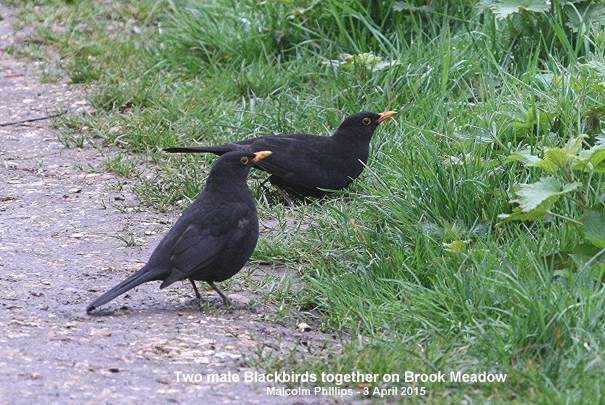
Malcolm also watched
from the foot bridge at the top of Peter Pond and saw
the regular Chiffchaff plus 2 Coots.
THURSDAY
APRIL 2 - 2015
Millpond
News
The pen swan
was snug on the reed nest by the bridge on the town
millpond at 10am this morning. She has probably
started brooding the 7 eggs and will be on the nest
for the next 36 days except for brief periods for
feeding when the cob takes over. The predicted date
for hatching is May 8th.
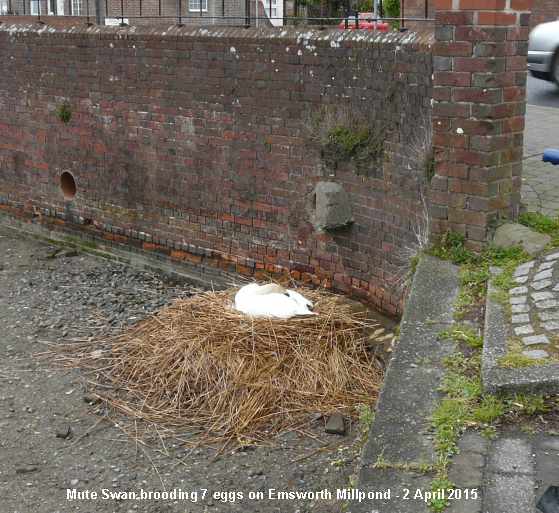
Brook
Meadow
At about 12.40
this afternoon Malcolm Phillips saw what was almost
certainly a Roe Deer run across the Lumley area
of Brook Meadow to the east corner and across the
Lumley Stream onto Lumley Road. We do occasionally get
deer sightings on Brook Meadow though this was the
first for a couple of years. However, we probably miss
some. I found some deer droppings on the east side of
the north meadow by Beryl's seat on 20-Aug last
year.
Malcolm also spotted a large Pike in the river
by the large Ash tree at the north west corner. Bad
news for our Water Voles. He also found again both a
Common Chiffchaff and the pink-legged bird that we
think might be a Willow Warbler in the reeds
north of Peter Pond.
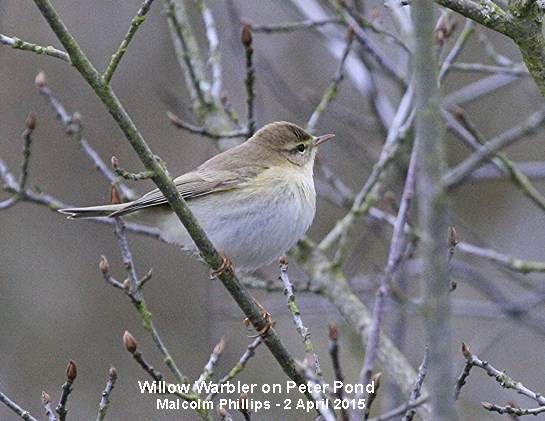
While Colin
Brotherston and I were installing a new perspex window
in the Water Vole signcase in Palmer's Road Copse this
morning, Jennifer Rye alerted me to the presence of a
small crop of white Sweet Violets that were in
flower immediately in front of the new Local Nature
Reserve sign at the northern end of the path through
the copse. These were the first white ones recorded on
the Brook Meadow site.
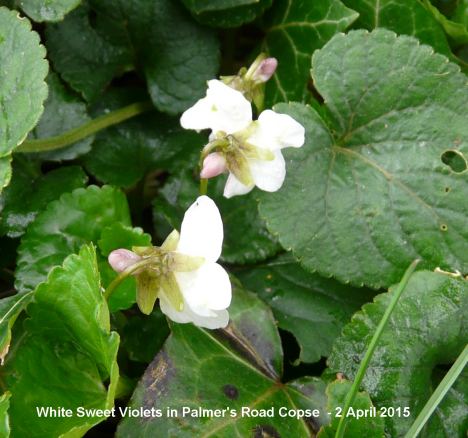
WEDNESDAY
APRIL 1 - 2015
Malcolm's
news
Malcolm
Phillips was on the meadow today and saw two Buzzards
soaring to the north of the meadow and a Kestrel
flying over at the same time. He also saw what he
thought at first was a Water Vole at the top of Peter
Pond, but it turned out to be a Brown Rat.
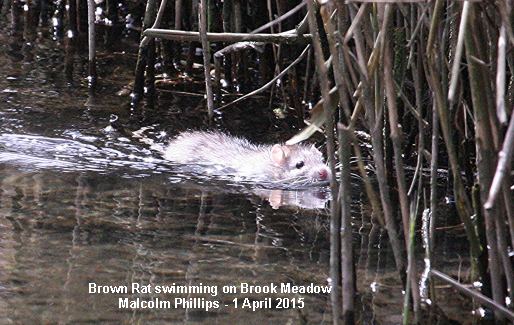
More interestingly, at
the top of Peter Pond Malcolm got this photo of what
he thought could be a Willow Warbler, because
of its pink legs. Malcolm's book says a Chiffchaff
never has pink legs.
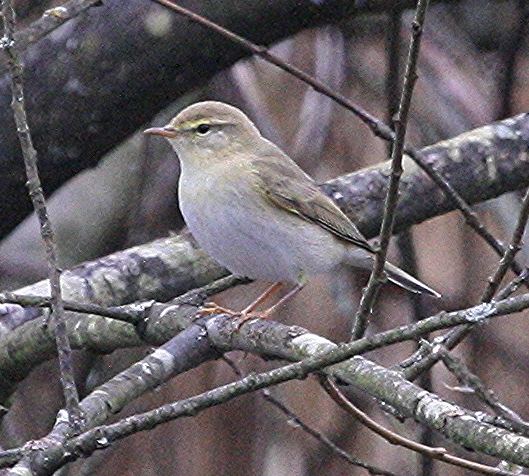
I would have said
Chiffchaff, but those legs are very suggestive of a
Willow Warbler. Willow Warbler is certainly a
possibility, as there have been numerous early
sightings of them in the local area. Peter
Milinets-Raby had one at Nore Barn on Mar 27 and
Martin Hampton had one singing in Havant on Mar 30. I
cannot see the relative lengths of the tertial length
and the primary projection which would differentiate
Willow Warbler from Chiffchaff. Personally, I would
wait until I heard one sing before I drew any hard and
fast conclusions. What do you think?
For
earlier observations go to . . . March
17-31